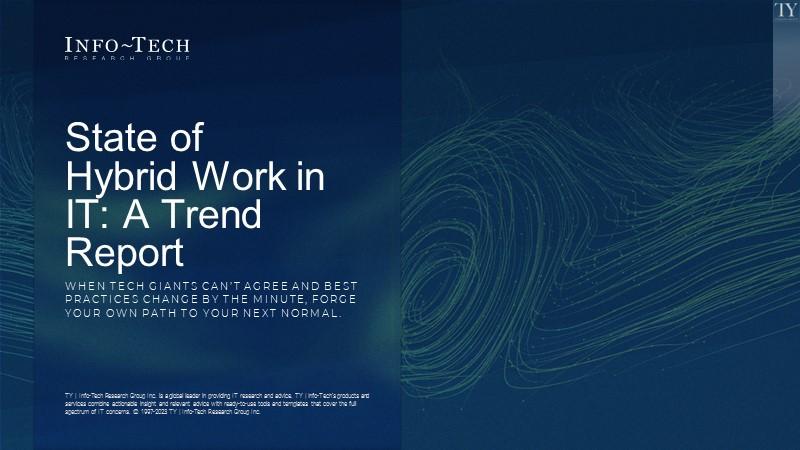
State of Hybrid Work in IT
Hybrid work is here, but there is no consensus among industry leaders on how to do it right. IT faces the dual challenge of supporting its own employees while enabling the success of the broader organization. In the absence of a single best practice to adopt, how can IT departments make the right decisions when it comes to the new world of hybrid?
Our Advice
Critical Insight
- Don’t make the mistake of emulating the tech giants, unless they are your direct competition. Instead, look to organizations that have walked your path in terms of scope, organizational goals, industry, and organizational structure. Remember, your competitors are not just those who compete for the same customers but also those who compete for your employees.
- Hybrid and remote teams require more attention, connection, and leadership from managers. The shift from doing the day-to-day to effectively leading is critical for the success of nontraditional work models. As hybrid and remote work become engrained in society, organizations must ensure that the concept of the “working manager” is as obsolete as the rotary telephone.
Impact and Result
Read this concise report to learn:
- What other IT organizations are doing in the new hybrid world.
- How hybrid has impacted infrastructure, operations, and business relations.
- How to succeed at building a highly effective hybrid team.
- How Info-Tech can help you make hybrid an asset for your IT department.
State of Hybrid Work in IT Research & Tools
Besides the small introduction, subscribers and consulting clients within this management domain have access to:
1. State of Hybrid Work in IT: A Trend Report – A walkthrough of the latest data on the impact of the hybrid work revolution in IT.
Read this report to learn how IT departments are using the latest trends in hybrid work for greater IT effectiveness. Understand what work models are best for IT, how IT can support a remote organization, and how hybrid work changes team dynamics.
- State of Hybrid Work in IT: A Trends Report
Infographic

Further reading
State of Hybrid Work in IT: A Trend Report
When tech giants can’t agree and best practices change by the minute, forge your own path to your next normal.
Hybrid is here. Now how do we do this?
The pandemic has catapulted hybrid work to the forefront of strategic decisions an organization needs to make. According to our State of Hybrid Work in IT survey conducted in July of 2022, nearly all organizations across all industries are continuing some form of hybrid or remote work long-term (n=518). Flexible work location options are the single greatest concern for employees seeking a new job. IT departments are tasked with not only solving hybrid work questions for their own personnel but also supporting a hybrid-first organization, which means significant changes to technology and operations.
Faced with decisions that alter the very foundation of how an organization functions, IT leaders are looking for best practices and coming up empty. The world of work has changed quickly and unexpectedly. If you feel you are “winging it” in the new normal, you are not alone.
95% of organizations are continuing some form of hybrid or remote work.
n=518
47% of respondents look at hybrid work options when evaluating a new employer, vs. 46% who look at salary.
n=518
Hybrid work model decision tree
Your organization, your employees, your goals – your hybrid work
The days of a “typical” workplace have passed. When it comes to the new world of hybrid work, there is no best-of-breed example to follow.
Among the flood of contradictory decisions made by industry leaders, your IT organization must forge its own path, informed by the needs of your employees and your organizational goals.
All IT work models can support the broader organization. However, IT is more effective in a hybrid work mode.
Stay informed on where your industry is headed, but learn from, rather than follow, industry leaders.
All industries reported primarily using partial, balanced & full hybrid work models.
All industries reported some fully remote work, ranging from 2-10% of organizations surveyed.
Construction and healthcare & life sciences did not require any fully in-office work. Other industries, between 1-12% required fully in-office work.
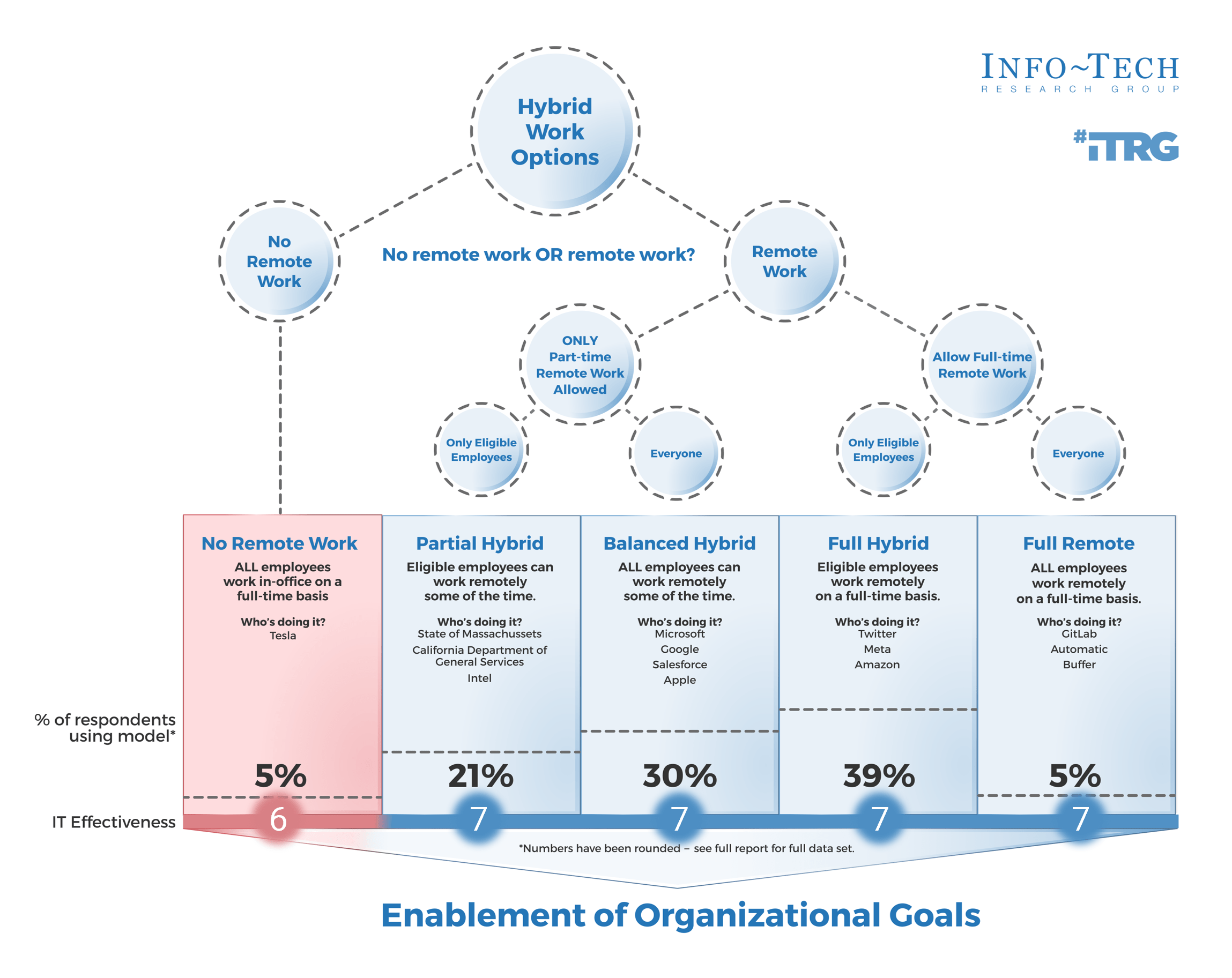
Move beyond following tech giants
The uncomfortable truth about hybrid work is that there are many viable models, and the “best of breed” depends on who you ask. In the post-pandemic workspace, for every work location model there is an industry leader that has made it functional. And yet this doesn’t mean that every model will be viable for your organization.
In the absence of a single best practice, rely on an individualized cost-benefit assessment rooted in objective feasibility criteria. Every work model – whether it continues your status quo or overhauls the working environment – introduces risk. Only in the context of your particular organization does that risk become quantifiable.
Don’t make the mistake of emulating the tech giants, unless they are your direct competition. Instead, look to organizations that have walked your path in terms of scope, organizational goals, industry, and organizational structure.
|
External |
Internal |
|---|---|
|
Political Economic Social Technological Legal Environmental |
Operations Culture Resources Risk Benefit Employee Preferences |
Comparative
Your competitors
Info-Tech Insight
Remember, your competitors are not just those who compete for the same customers but also those who compete for your employees.
IT must balance commitments to both the organization and its employees
IT has two roles: to effectively support the broader organization and to function effectively within the department. It therefore has two main stakeholder relationships: the organization it supports and the employees it houses. Hybrid work impacts both. Don't make the mistake of overweighting one relationship at the expense of the other. IT will only function effectively when it addresses both.
Track your progress with the right metrics
|
IT and the organization
|
Diagnostic tool: Business Vision |
|
IT and its employees
|
Diagnostic tool: |
This report contains:
- IT and the Organization
- IT Effectiveness
in a Hybrid World - The Impact of Hybrid on Infrastructure & Operations
- IT Effectiveness
- IT and Its Employees
- What Hybrid Means for the IT Workforce
- Leadership for Hybrid IT Teams
This report is based on organizations like yours

This report is based on organizations like yours
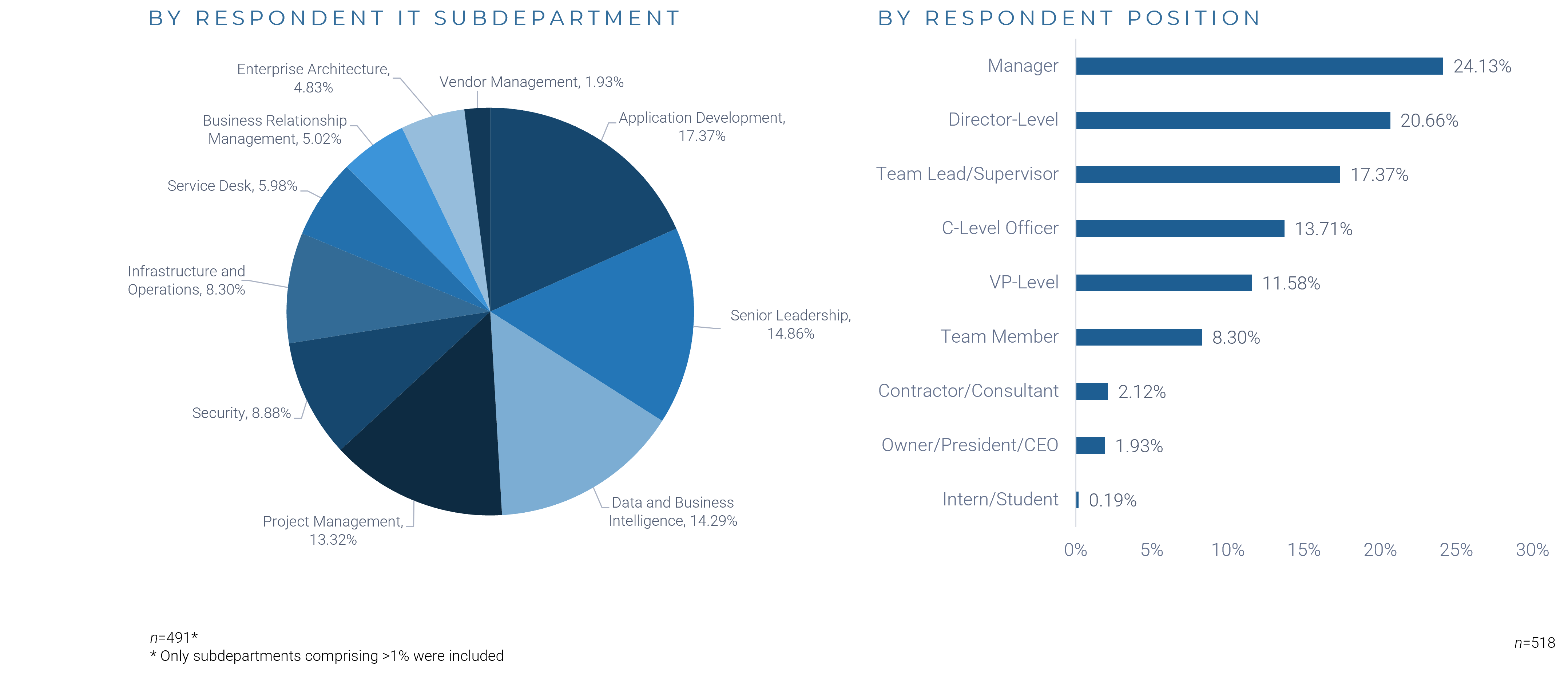
This report is based on organizations like yours

This report is based on organizations like yours
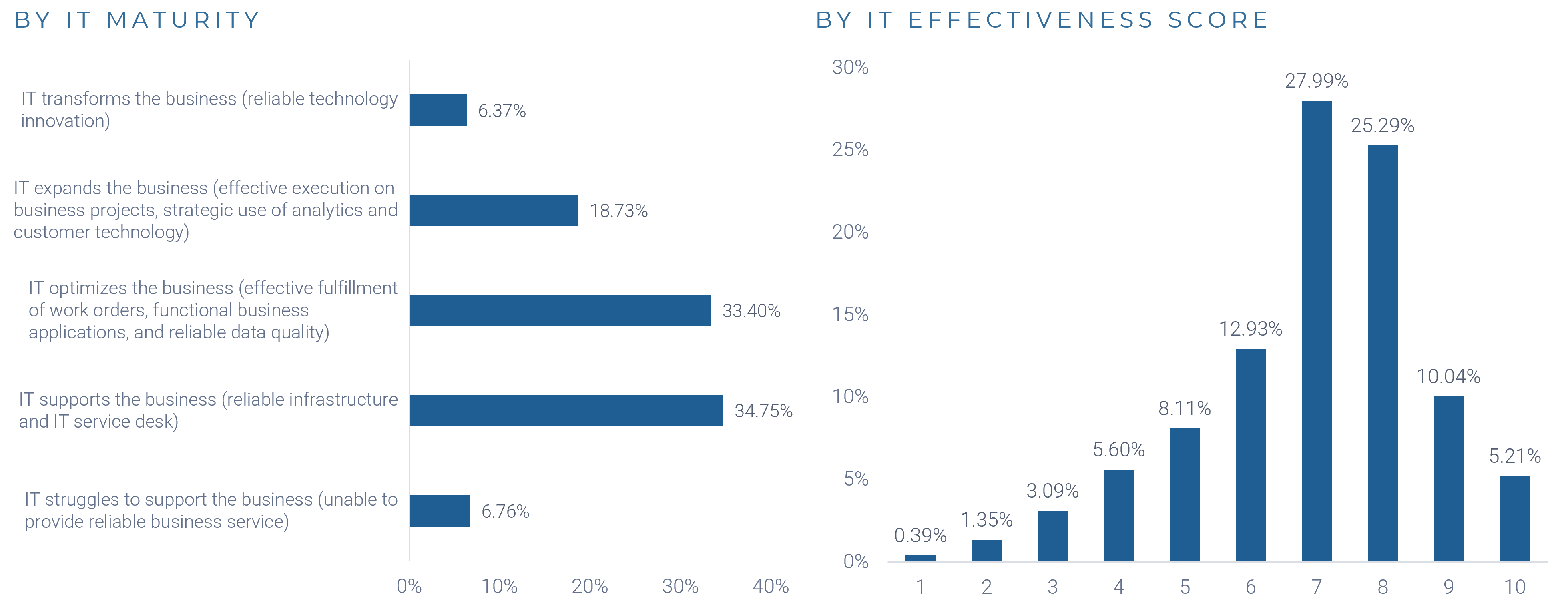
At a high level, hybrid work in IT is everywhere
INDUSTRY
|
|
ORGANIZATIONAL SIZE
|
Small <100 |
Medium 101-5,000 |
Large >5,000 |
|
Employees |
POSITION LEVEL
- Executive
- Director
- Supervisor/Manager
- Student/Contractor/Team Member
100% of industries, organizational sizes, and position levels reported some form of hybrid or remote work.
Work model breakdown at the respondent level
| 5% | 21% | 30% | 39% | 5% |
|
No Remote |
Partial Hybrid |
Balanced Hybrid |
Full Hybrid |
Full Remote Work |
n=516
Industry lens: Work location model
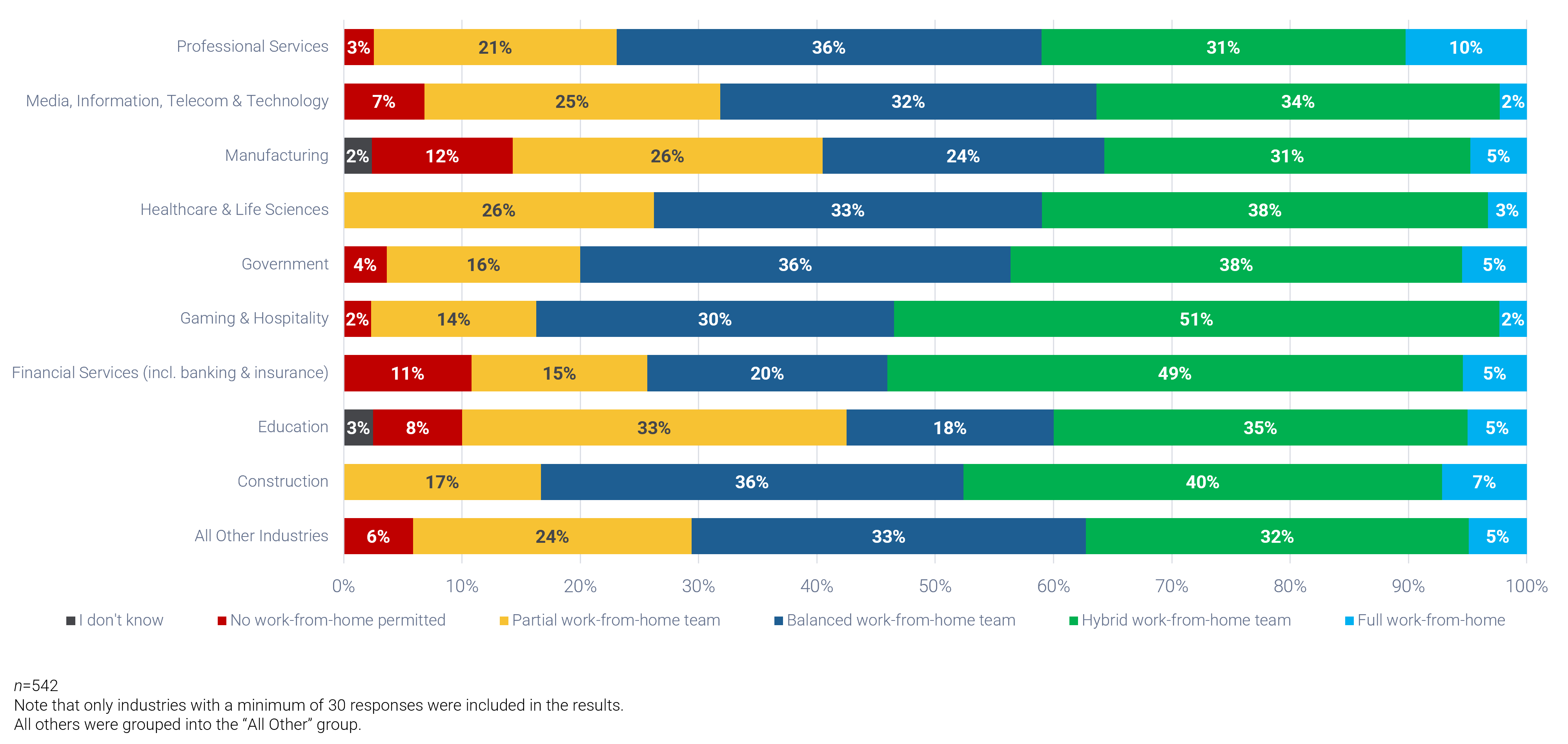
Percentage of IT roles currently in a hybrid or remote work arrangement

Work location model by organization size

Hybrid work options
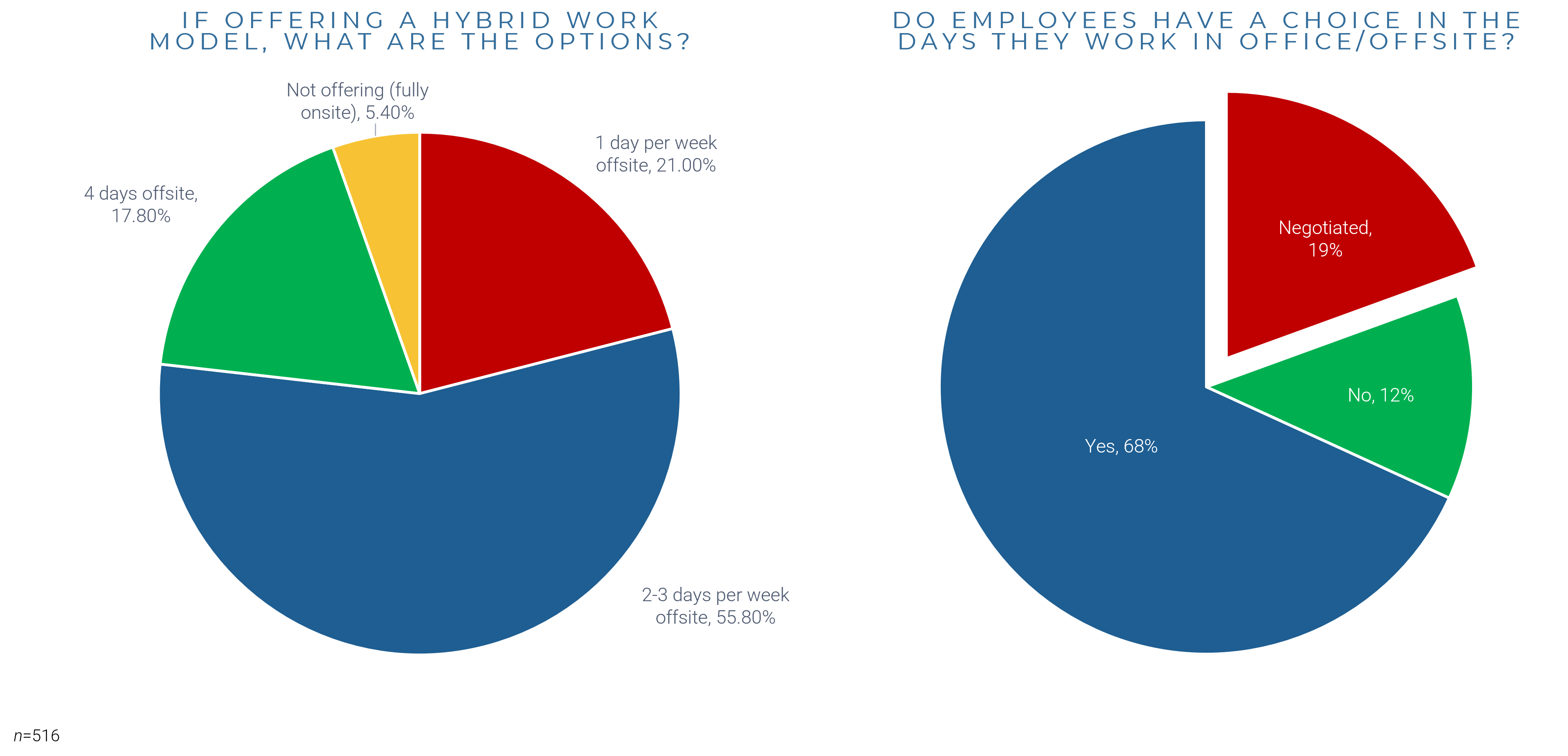
Expense reimbursement
| 28% | 27% | 22% | 26% | 13% | 4% |
|
None |
Internet/home phone |
Just internet |
Home office setup |
Home utilities |
Other |
NOTES
n=518
Home office setup: One-time lump-sum payment
Home utilities: Gas, electricity, lights, etc.
Other: Office supplies, portion of home rent/mortgage payments, etc.
01 TECHNOLOGY
IT and the Organization
Section 1
The promise of hybrid work for IT department effectiveness and the costs of making it happen
In this section:
- IT Effectiveness in a Hybrid World
- The Impact of Hybrid on Infrastructure & Operations
Hybrid work models in IT bolster effectiveness
IT’s effectiveness, meaning its ability to enable organizational goal attainment, is its ultimate success metric. In the post-pandemic world, this indicator is intimately tied to IT’s work location model, as well as IT’s ability to support the work location model used by the broader organization.
In 2022, 90% of organizations have embraced some form of hybrid work (n=516). And only a small contingent of IT departments have more than 90% of roles still working completely in office, with no remote work offered (n=515).
This outcome was not unexpected, given the unprecedented success of remote work during the pandemic. However, the implications of this work model were far less certain. Would productivity remain once the threat of layoffs had passed? Would hybrid work be viable in the long term, once the novelty wore off? Would teams be able to function collaboratively without meeting face to face? Would hybrid allow a great culture
to continue?
All signs point to yes. For most IT departments, the benefits of hybrid work outweigh its costs. IT is significantly more effective when some degree of remote or hybrid work is present.
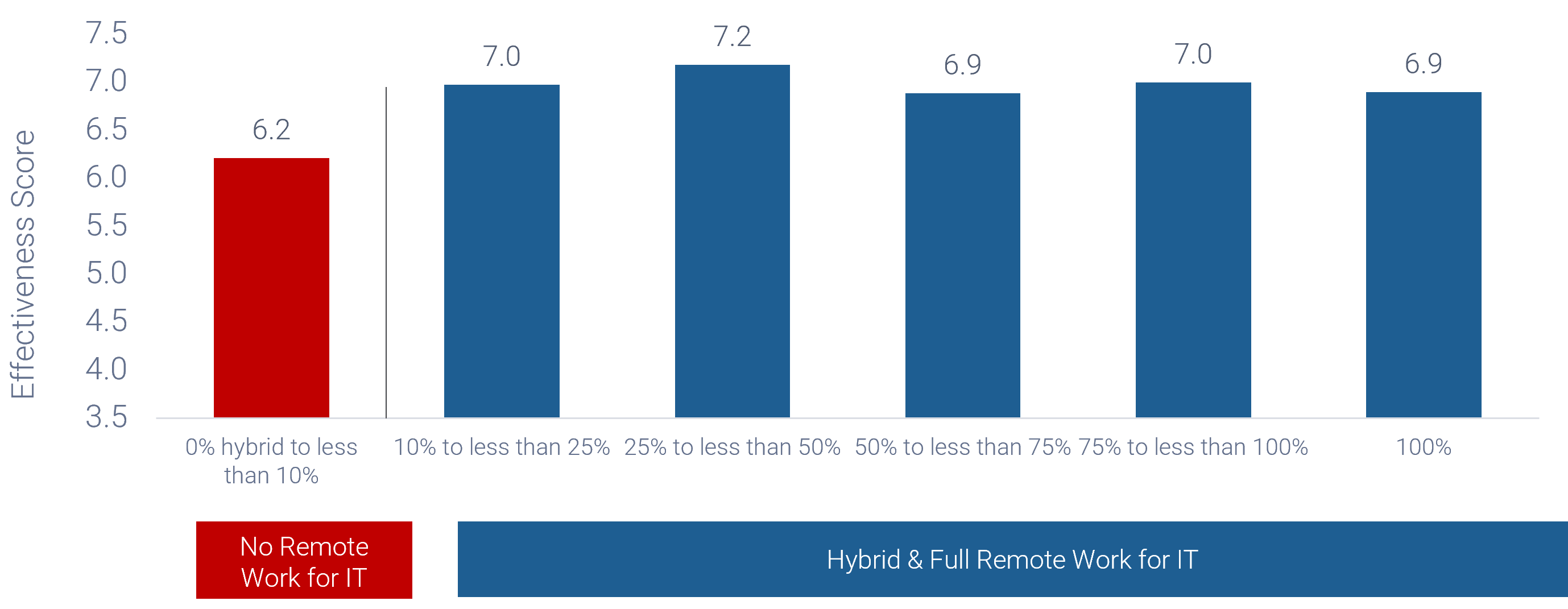
n=518
Remote Work Effectiveness Paradox
When IT itself works fully onsite, lower effectiveness is reported (6.2). When IT is tasked with supporting fully, 100% remote organizations (as opposed to being fully remote only within IT), lower effectiveness is reported then as well (5.9). A fully remote organization means 100% virtual communication, so the expectations placed on IT increase, as do the stakes of any errors. Of note, hybrid work models yield consistent effectiveness scores when implemented at both the IT and organizational levels.
IT has risen to the challenge of hybrid
Despite the challenges initially posed by hybrid and remote organizations, IT has thrived through the pandemic and into this newly common workplace.
Most organizations have experienced an unchanged or increased level of service requests and incidents. However, for the majority of organizations, service desk support has maintained (58%) or improved (35%). Only 7% of IT organizations report decreased service desk support.
Is your service desk able to offer the same level of support compared to the pre-pandemic/pre-hybrid work model?

How has the volume of your service requests/incidents changed?
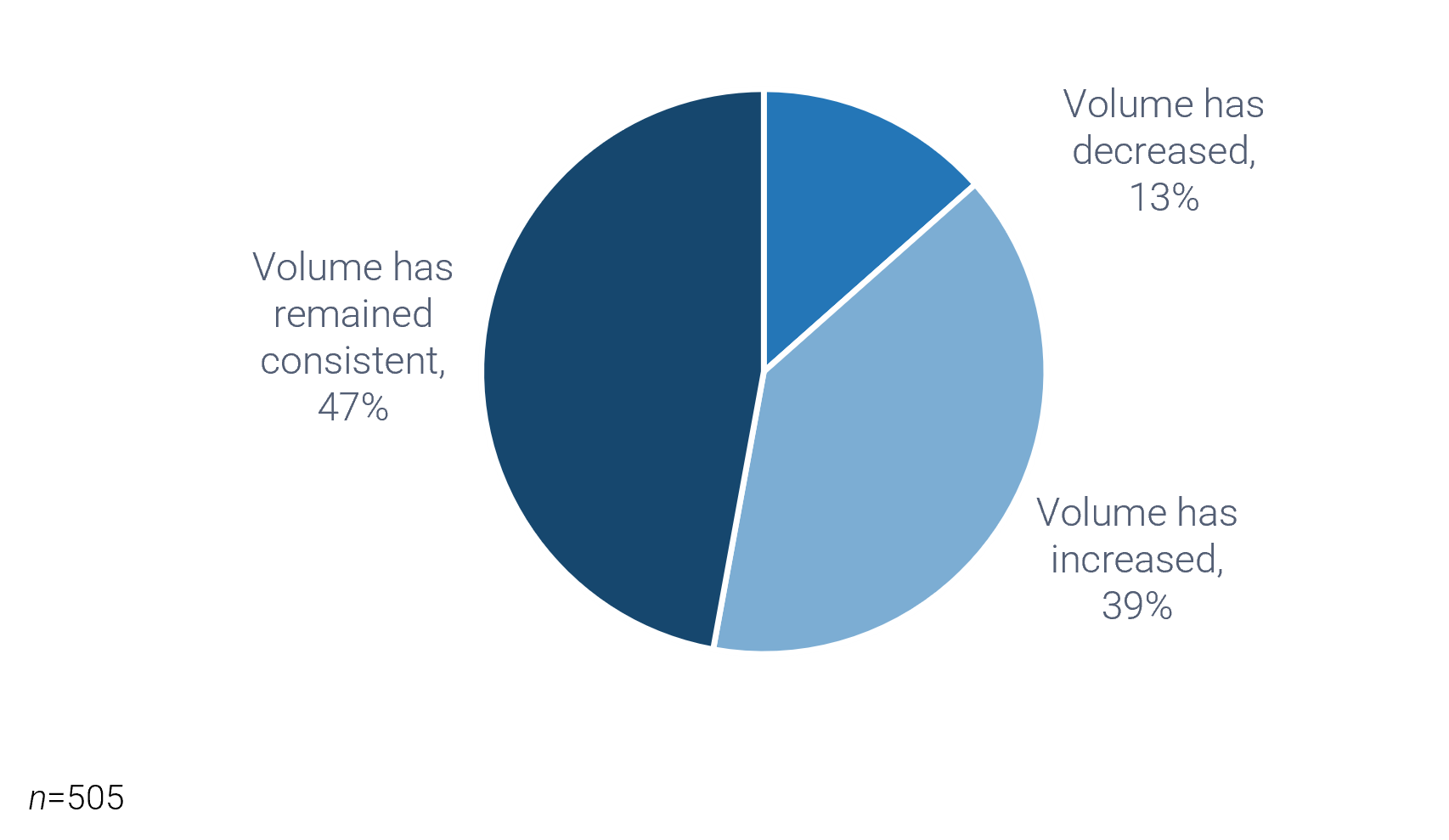
Has hybrid work impacted your customer satisfaction scores?

Industry lens: Volume of service requests
It is interesting to note that service request volumes have evolved similarly across industries, mirroring the remarkable consistency with which hybrid work has been adopted across disparate fields, from construction to government.
Of note are two industries where the volume of service requests mostly increased: government and media, information, telecom & technology.
With the global expansion of digital products and services through the pandemic, it’s no surprise to see volumes increase for media, information, telecom & technology. With government, the shift from on premises to rapid and large-scale hybrid or remote work for administrative and knowledge worker roles likely meant additional support from IT to equip employees and end users with the necessary tools to carry out work offsite.
How has the volume of your service requests/incidents changed?
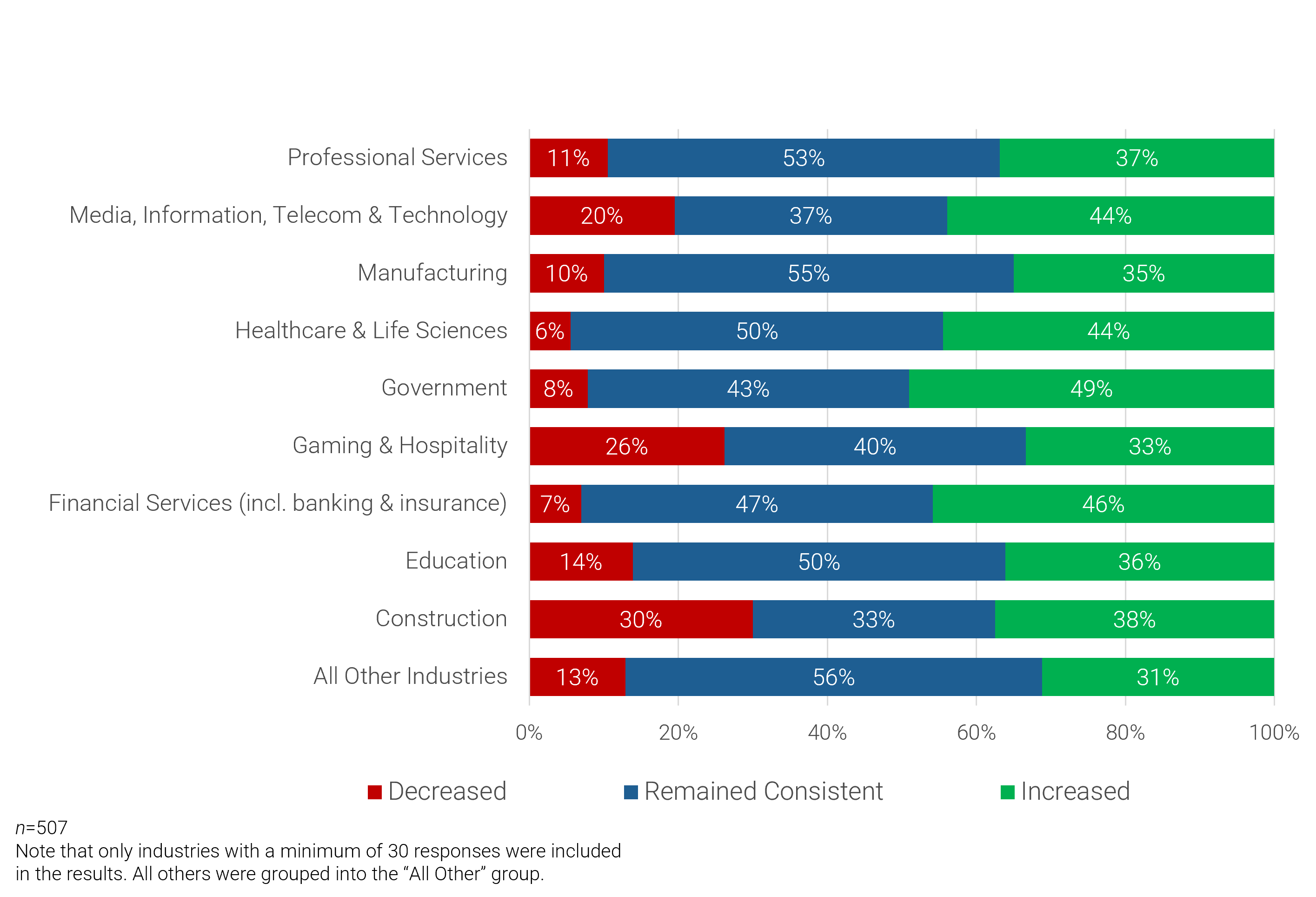
The transition to hybrid was worth the effort
Hybrid and remote work have been associated with greater productivity and organizational benefits since before the pandemic. During emergency remote work, doubts arose about whether productivity would be maintained under such extreme circumstances and were quickly dispelled. The promise of remote productivity held up.
Now, cautiously entering a “new normal,” the question has emerged again. Will long-term hybrid work bring the same benefits?
The expectations have held up, with hybrid work benefits ranging from reduced facilities costs to greater employee performance.
Organizational hybrid work may place additional strain on IT,
but it is clear IT can handle the challenge. And when it does,
the organizational benefits are tremendous.
88% of respondents reported increased or consistent Infrastructure & Operations customer satisfaction scores.
What benefits has the organization achieved as a result of moving to a hybrid work model?
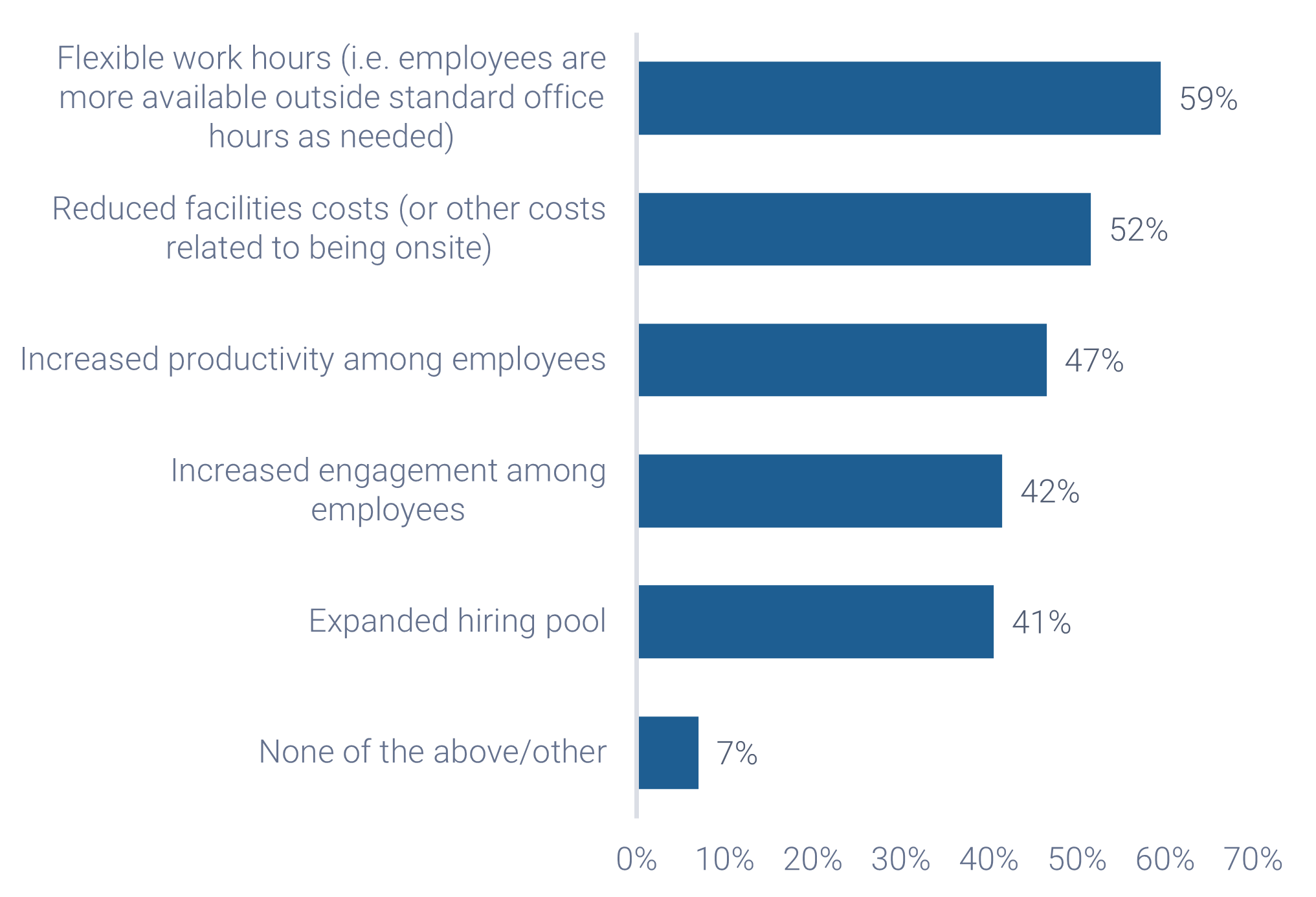
n=487
Hybrid has sped up modernization of IT processes and infrastructure
Of the organizations surveyed, the vast majority reported significant changes to both the process and the technology side of IT operations. Four key processes affected by the move to hybrid were:
- Incident management
- Service request support
- Asset management
- Change management
Within Infrastructure & Operations, the area with the greatest degree
of change was network architecture (reported by 44% of respondents), followed closely by service desk (41%) and recovery workspaces and mitigations (40%).
63% of respondents reported changes to conference room technology to support hybrid meetings.
n=496
IT Infrastructure & Operations changes, upgrades, and modernization
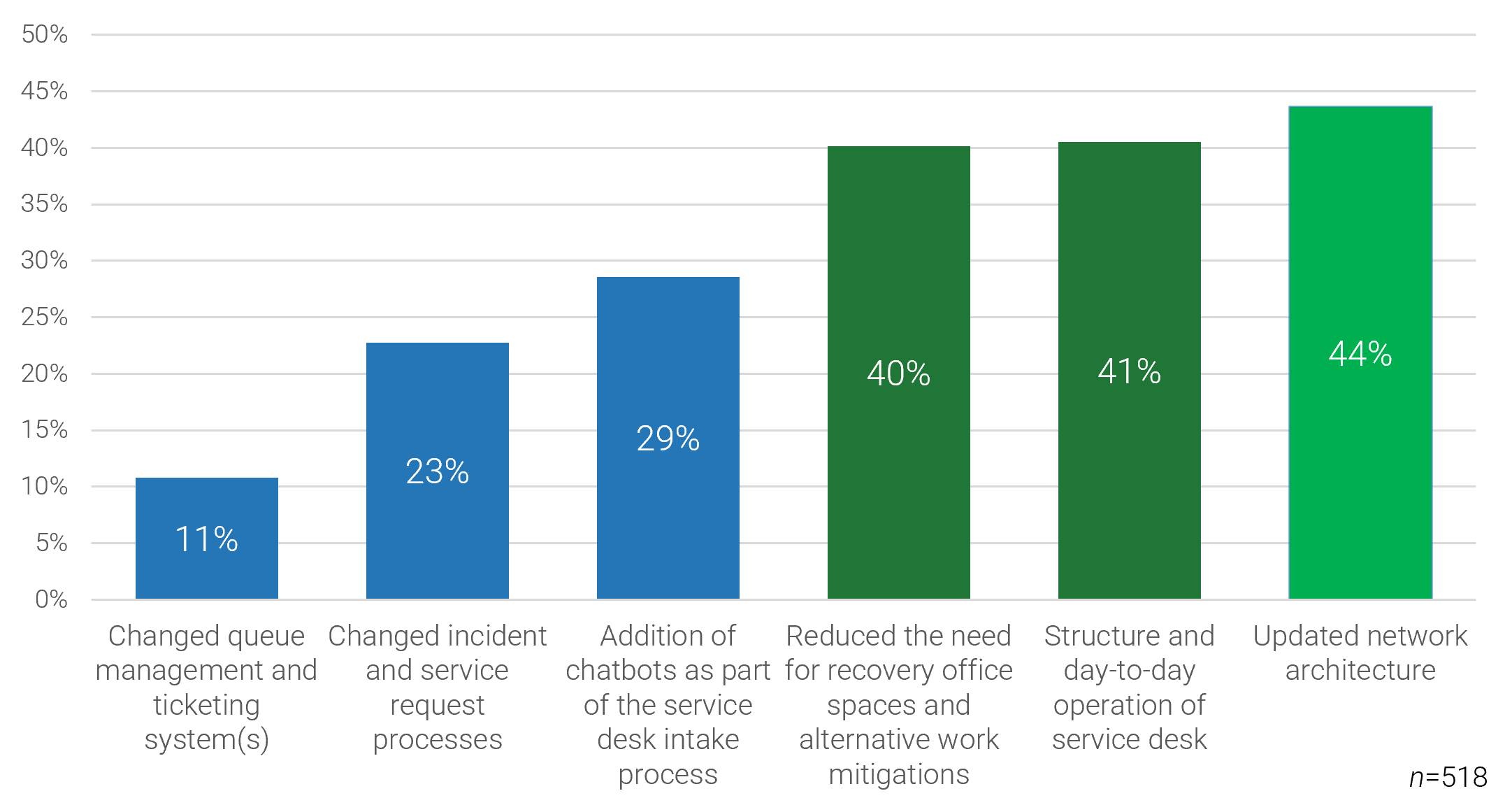
What process(es) had the highest degree of change in response to supporting hybrid work?

Hybrid has permanently changed deployment strategy
Forty-five percent of respondents reported significant changes to deployment as a result of hybrid work, with an additional 42% reporting minor changes. Only 13% of respondents stated that their deployment processes remained unchanged following the shift to hybrid work.
With the ever-increasing globalization of business, deployment modernization practices such as the shift to zero touch are no longer optional or a bonus. They are a critical part of business operation that bring efficiency benefits beyond just supporting hybrid work.
The deployment changes brought on by hybrid span across industries. Even in manufacturing, with the greatest proportion of respondents reporting “no change” to deployment practices (33%), most organizations experienced some degree of change.
Has a hybrid work model led you to make any changes to your deployment, such as zero touch, to get equipment to end users?
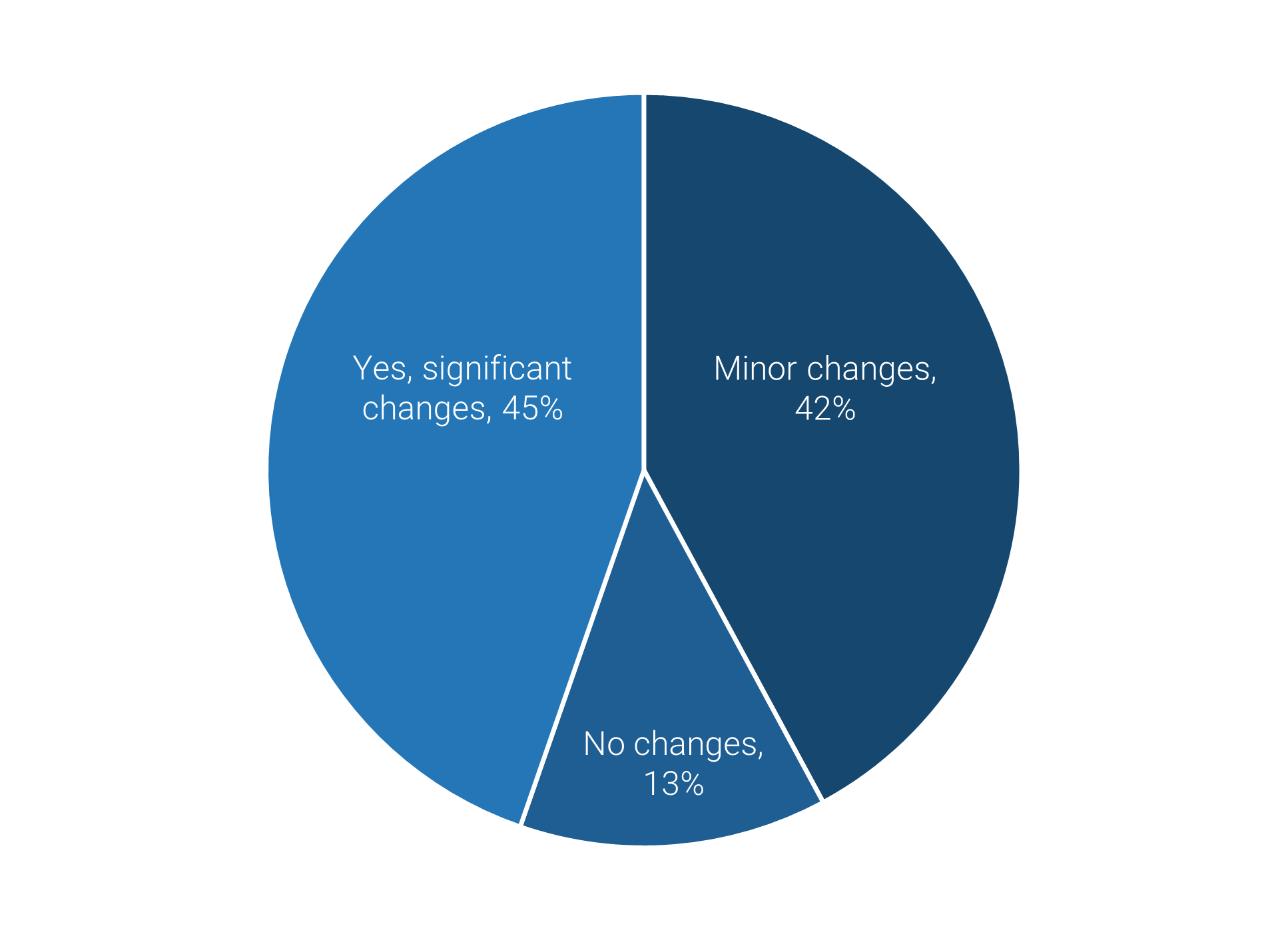
Industry lens: Deployment changes
Has a hybrid work model led you to make any changes to your deployment, such as zero touch, to get equipment to end users?
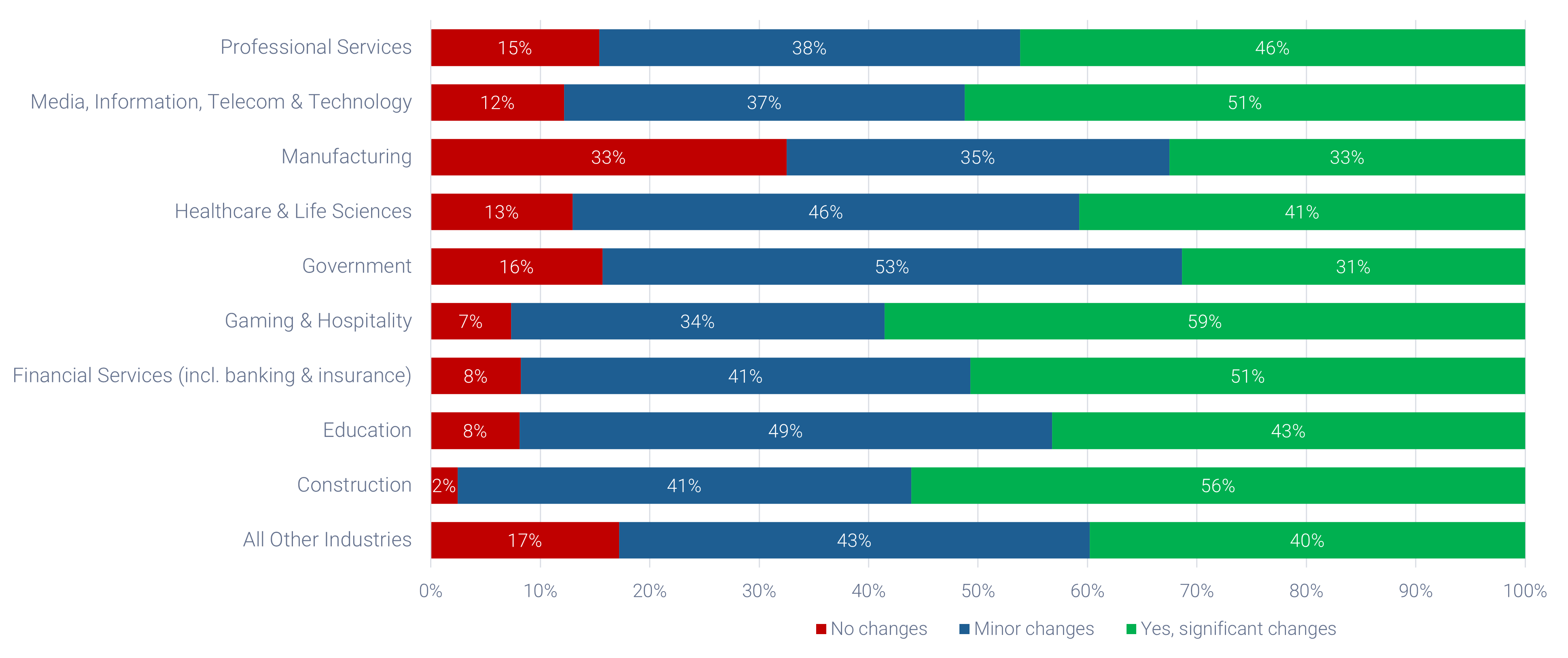
Hybrid work has accelerated organizational digitization
Over half of respondents reported significantly decreased reliance on printed copies as a result of hybrid. While these changes were on the horizon for many organizations even before the pandemic, the necessity of keeping business operations running during lockdowns meant that critical resources could be invested in these processes. As a result, digitization has leapt forward.
This represents an opportunity for businesses to re-evaluate their relationships with printing vendors. Resources spent on printing can be reduced or reallocated, representing additional savings as a result of moving to hybrid. Additionally, many respondents report a willingness – and ability – from vendors to partner with organizations in driving innovation and enabling digitization.
With respect to changes pertaining to hard copies/printers as a result of your hybrid work model:
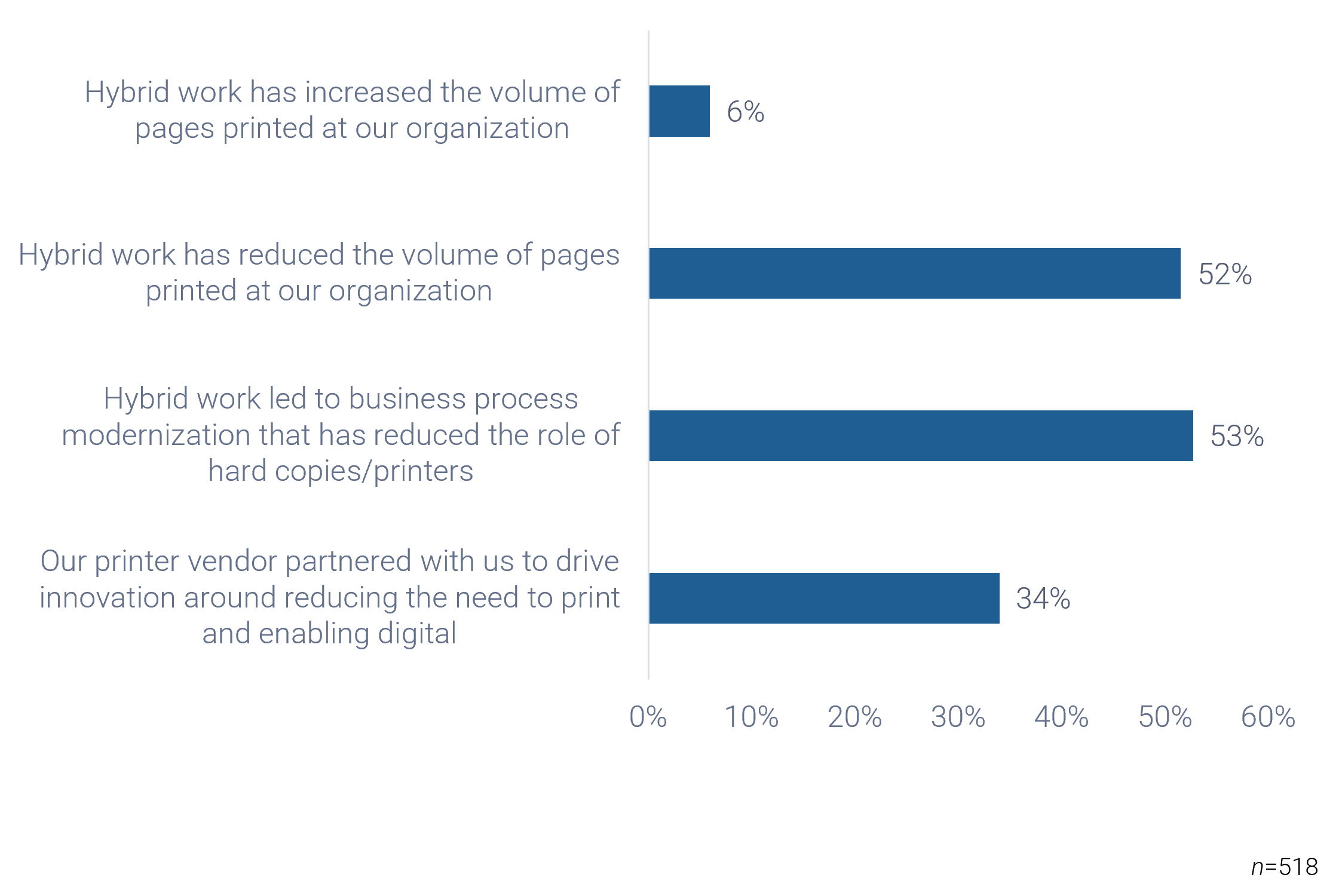
Hybrid work necessitates network and communications modernization
The majority (63%) of respondents reported making significant changes to conference room technology as a result of hybrid work. A significant proportion (30%) report that such changes were not needed, but this includes organizations who had already set up remote communication.
An important group is the remaining 8% of respondents, who cite budgetary restrictions as a key barrier in making the necessary technology upgrades. Ensure the business case for communication technology appropriately reflects the impact of these upgrades, and reduce the impact of legacy technology where possible:
- Recognize not just meeting efficiency but also the impact on culture, engagement, morale, and external and internal clients.
- Connect conference room tech modernization to the overall business goals and work it into the IT strategy.
- Leverage the scheduling flexibility available in hybrid work arrangements to reduce reliance on inadequate conference technology by scheduling in-person meetings where possible and necessary.
Have you made changes/upgrades
to the conference room technology to support hybrid meetings?
(E.g. Some participants joining remotely, some participants present in a conference room)
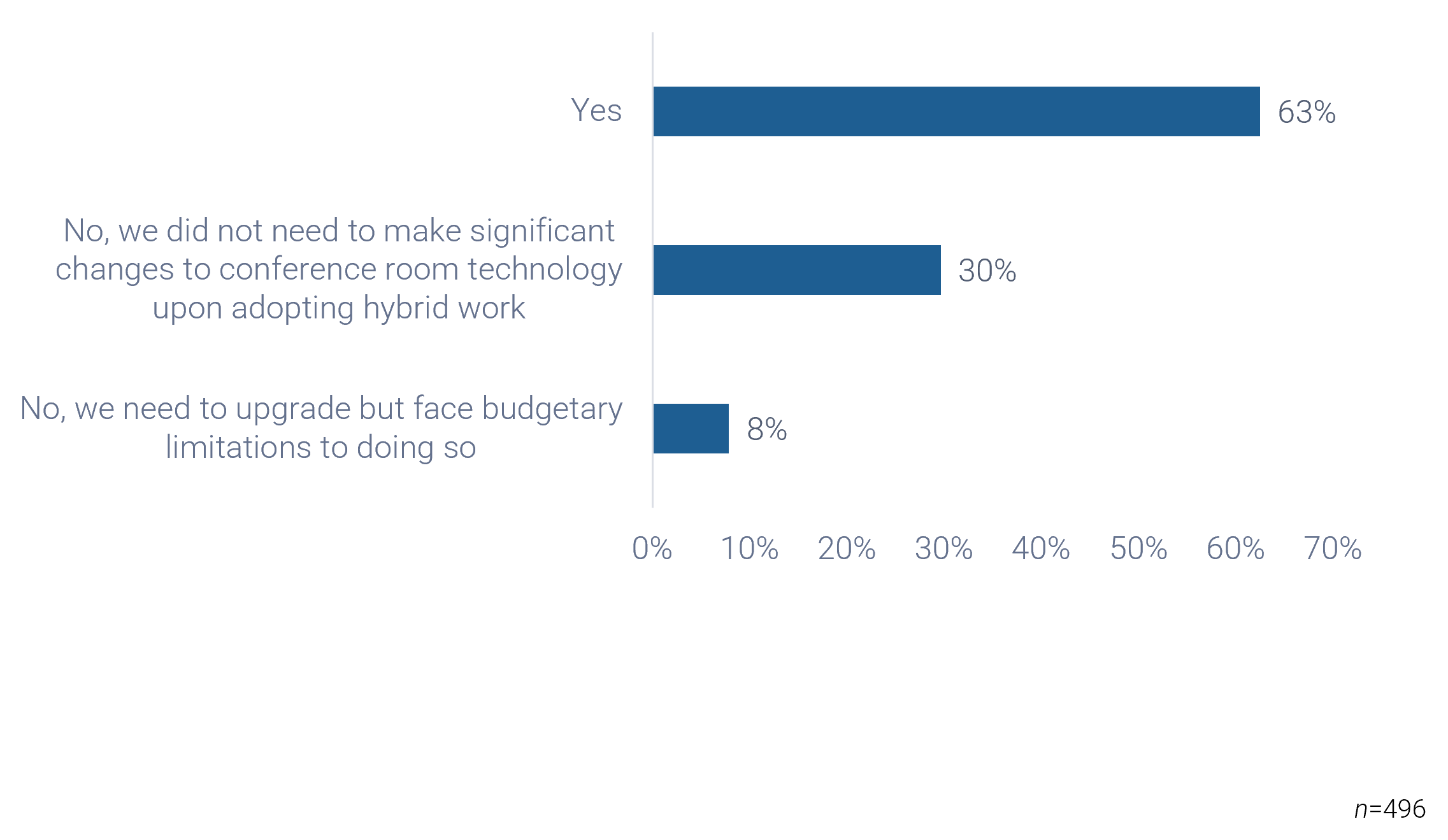
How we can help
|
Metrics
|
Resources Create a Work-From-Anywhere IT Strategy Stabilize Infrastructure & Operations During Work-From-Anywhere Sustain Work-From-Home in the New Normal |
For a comprehensive list of resources, visit
Info-Tech’s Hybrid Workplace Research Center
02 PEOPLE
IT and Its Employees
Section 2
Cultivate the dream team in a newly hybrid world
In this section:
- What Hybrid Means for the IT Workforce
- Leadership for IT Hybrid Teams
Hybrid means permanent change to how IT hires
Since before the pandemic, the intangibles of having a job that works with your lifestyle have been steadily growing in importance. Considerations like flexible work options, work-life balance, and culture are more important to employees now than they were two years ago, and employers must adapt.
Salary alone is no longer enough to recruit the best talent, nor is it the key to keeping employees engaged and productive. Hybrid work options are the single biggest concern for IT professionals seeking new employment, just edging out salary. This means employers must not offer just some work flexibility but truly embrace a hybrid environment.
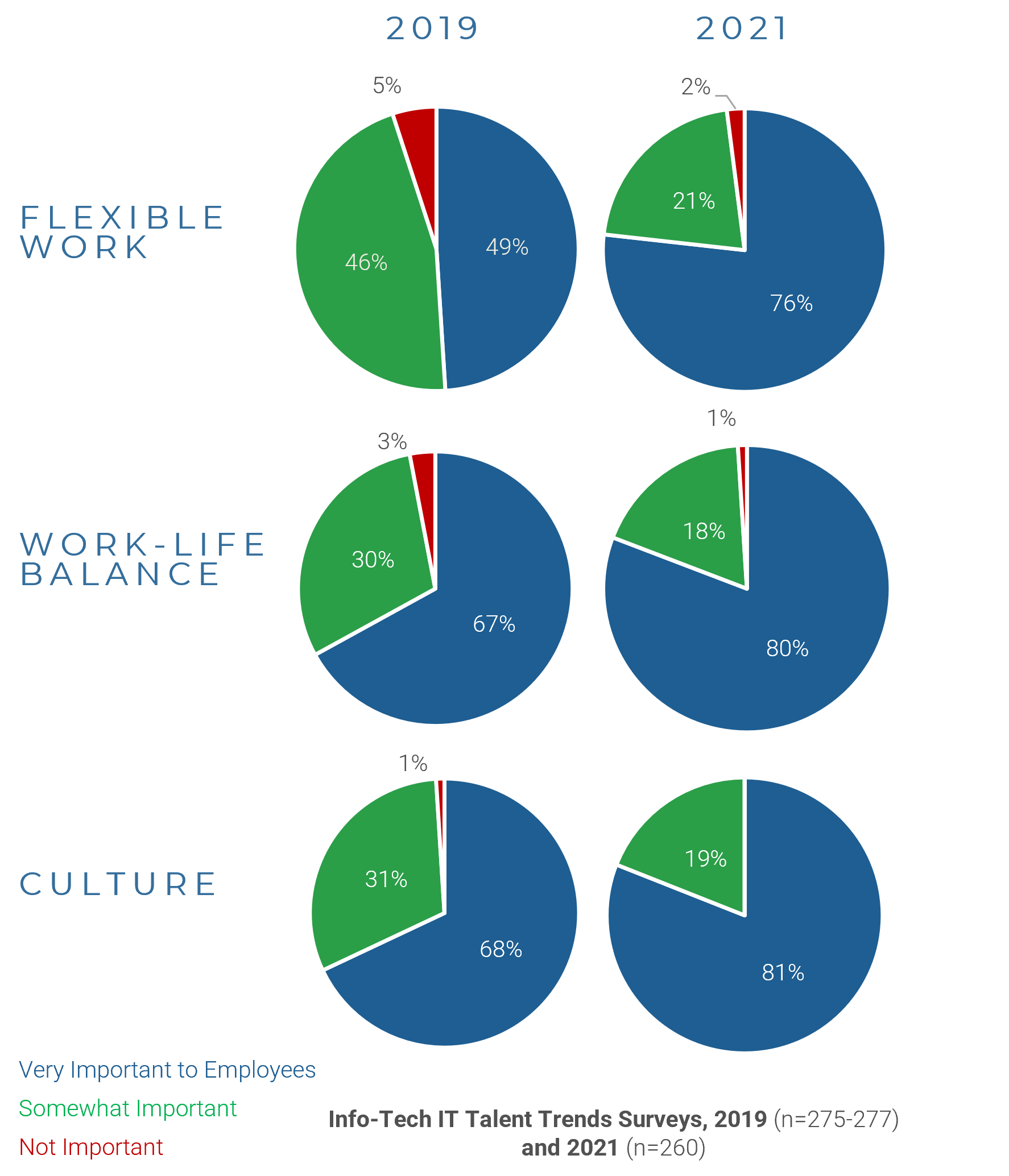
What are you considering when looking at a potential employer?
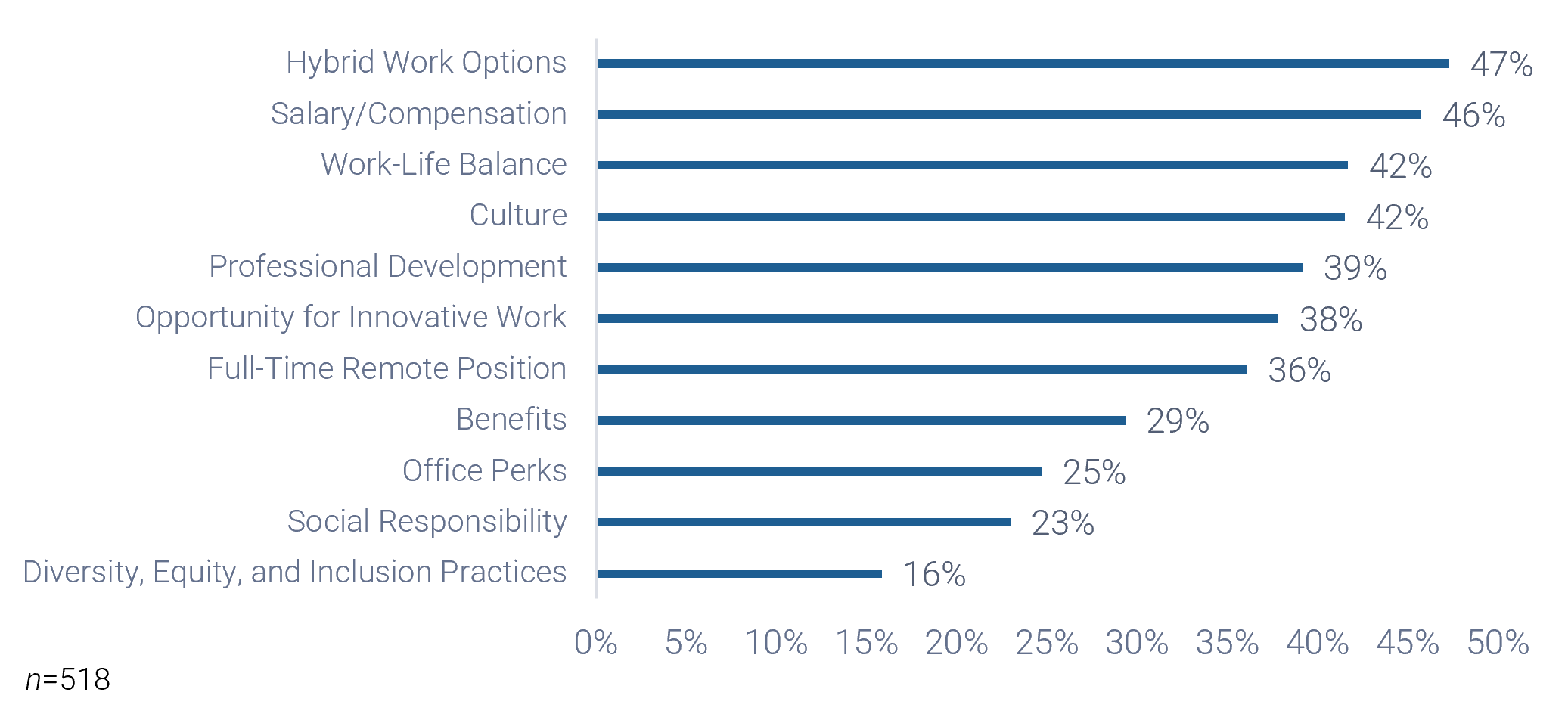
A recession may not significantly impact hybrid work decisions overall
Declining economic conditions suggest that a talent market shift may be imminent. Moving toward a recession may mean less competition for top talent, but this doesn't mean hybrid will be left behind as a recruitment tactic.
Just over half of IT organizations surveyed are considering expanding hybrid work or moving to fully remote work even in a recession. Hybrid work is a critical enabler of organizational success when resources are scarce, due to the productivity benefits and cost savings it has demonstrated. Organizations that recognize this and adequately invest in hybrid tools now will have equipped themselves with an invaluable tool for weathering a recession storm, should one come.
What impact could a potential recession in the coming year have on your decisions around your work location?
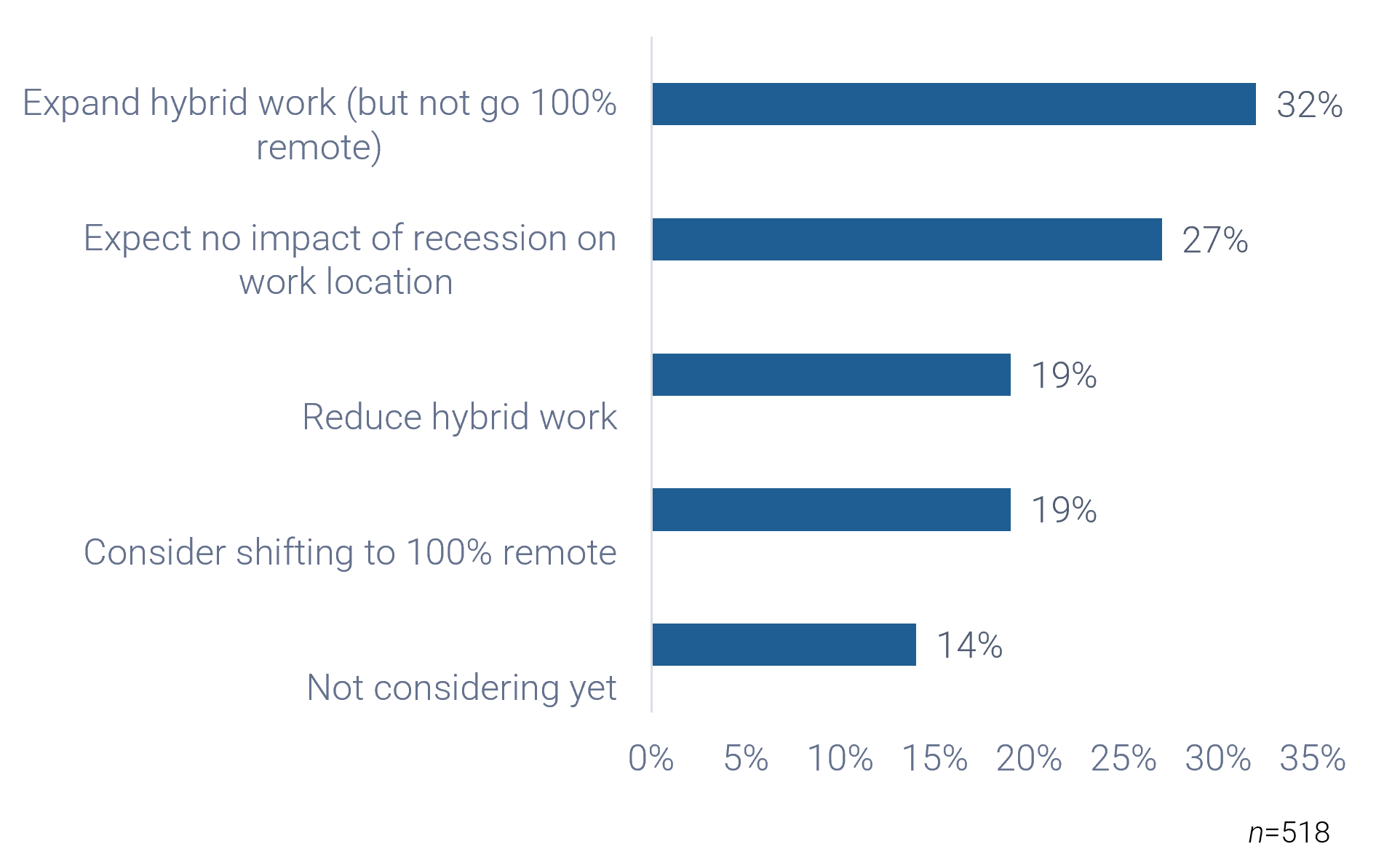
Hybrid work may help small organizations in a declining economy
The potential for a recession has a greater impact on the workforce decisions of small organizations. They likely face greater financial pressures than medium and large-sized organizations, pressures that could necessitate halting recruitment efforts or holding firm on current salaries and health benefits.
A reliance on intangible benefits, like the continuation of hybrid work, may help offset some of negative effects of such freezes, including the risk of lower employee engagement and productivity. Survey respondents indicated that hybrid work options (47%) were slightly more important to them than salary/compensation (46%) and significantly more important than benefits (29%), which could work in favor of small organizations in keeping the critical employees needed to survive an economic downturn.
|
Small |
Medium | Large |
| 90% | 82% | 66% |
Currently considering some form of hiring/salary freeze or cutbacks, if a recession occurs
NOTES
n=520
Small: <101 employees
Medium: 101-5000 employees
Large: >5,000 employees
Hybrid mitigates the main challenge of remote work
One advantage of hybrid over remote work is the ability to maintain an in-office presence, which provides a failsafe should technology or other barriers stand in the way of effective distance communication. To take full advantage of this, teams should coordinate tasks with location, so that employees get the most out of the unique benefits of working in office and remotely.
Activities to prioritize for in-office work:
- Collaboration and brainstorming
- Team-building activities
- Introductions and onboarding
Activities to prioritize for remote work:
- Individual focus time
As a leader, what are your greatest concerns with hybrid work?
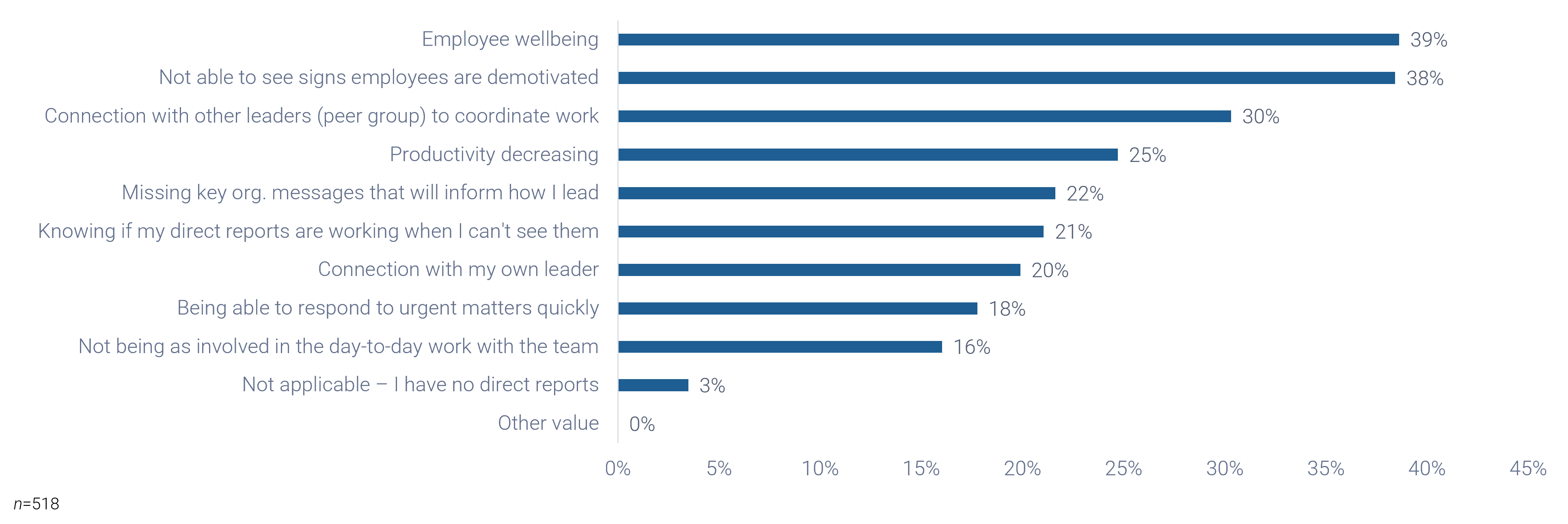
Hybrid necessitates additional effort by managers
When it comes to leading a hybrid team, there is no ignoring the impact of distance on communication and team cohesion. Among leaders’ top concerns are employee wellbeing and the ability to pick up on signs of demotivation among team members.
The top two tactics used by managers to mitigate these concerns center on increasing communication:
- Staying available through instant messaging.
- Increasing team meetings.
Tactics most used by highly effective IT departments
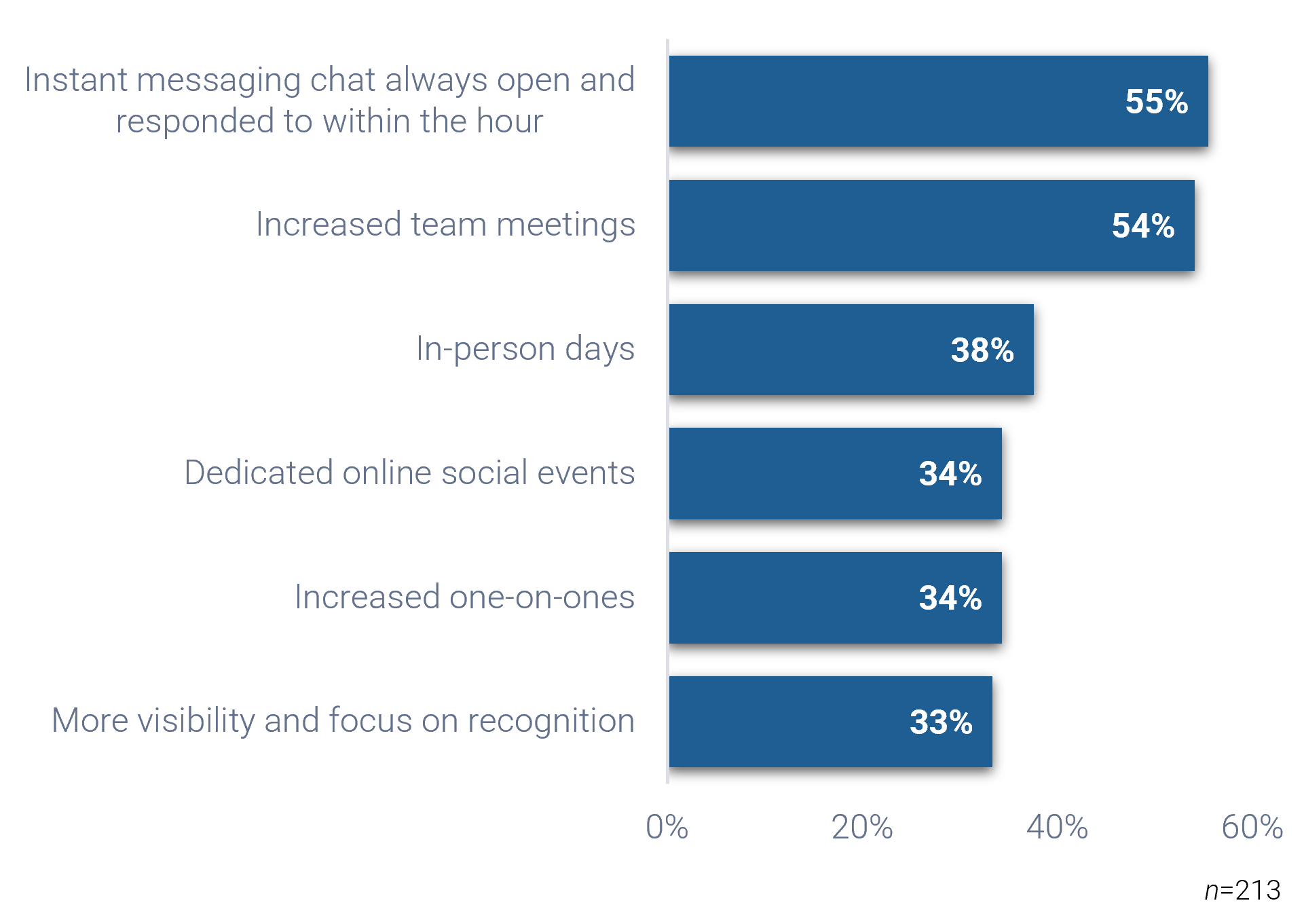
Team success is linked to the number of tools at the manager’s disposal
The most effective hybrid team management tools focus on overcoming the greatest obstacle introduced by remote work: barriers to communication and connection.
The most effective IT organizations use a variety of tactics. For managers looking to improve hybrid team effectiveness, the critical factor is less the tactic used and more the ability to adapt their approach to their team’s needs and incorporate team feedback. As such, IT effectiveness is linked to the total number of tactics used by managers.
IT department effectiveness
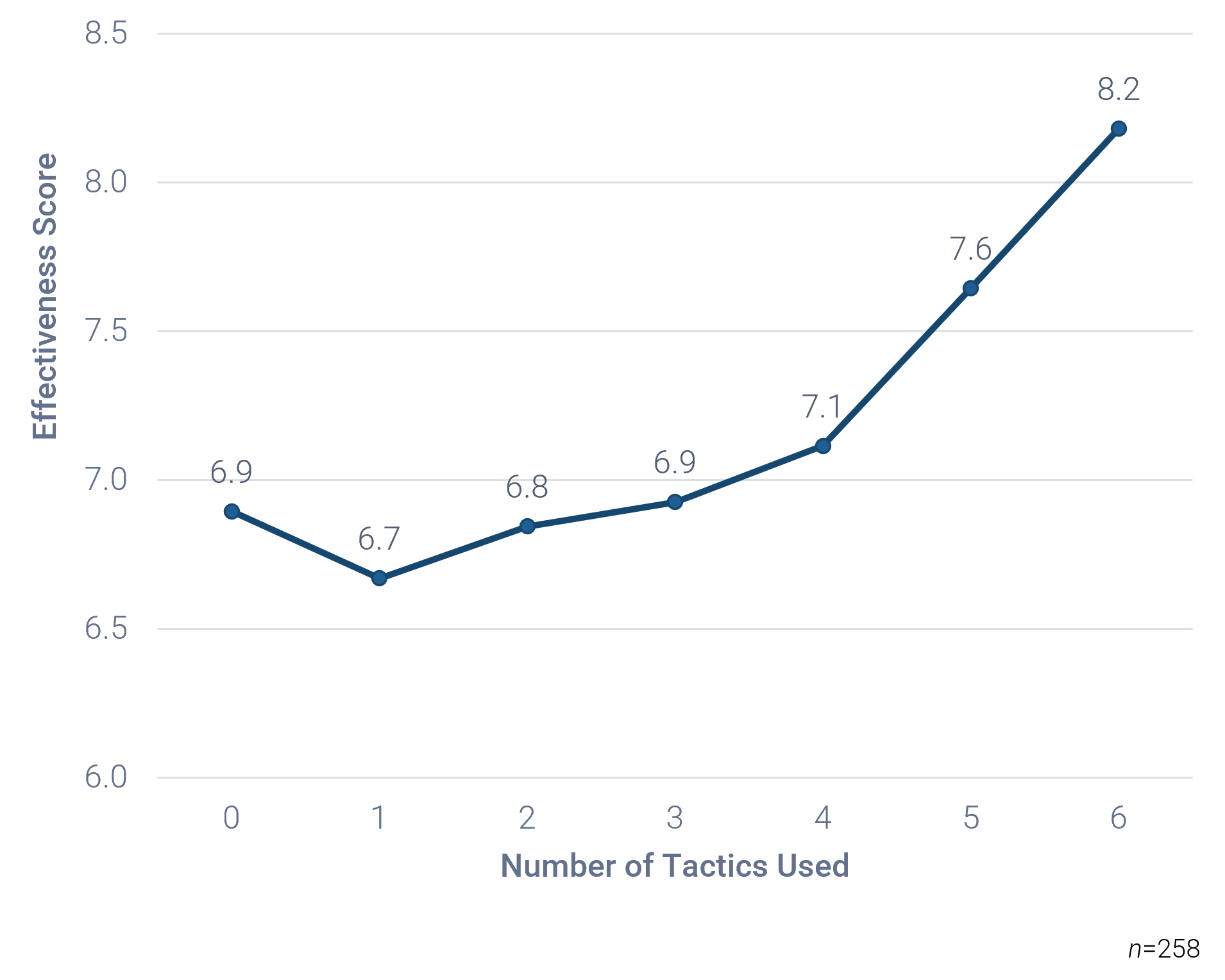
Autonomy is key to hybrid team success
Not all hybrid work models are created equal. IT leaders working with hybrid teams have many decisions to make, from how many days will be spent in and out of office to how much control employees get over which days they work remotely.
Employee and manager preferences are largely aligned regarding the number of days spent working remotely or onsite: Two to three days in office is the most selected option for both groups, although overall manager preferences lean slightly toward more time spent in office.
Comparison of leader and employee preference for days in-office

Do employees have a choice in the days they work in office/offsite?
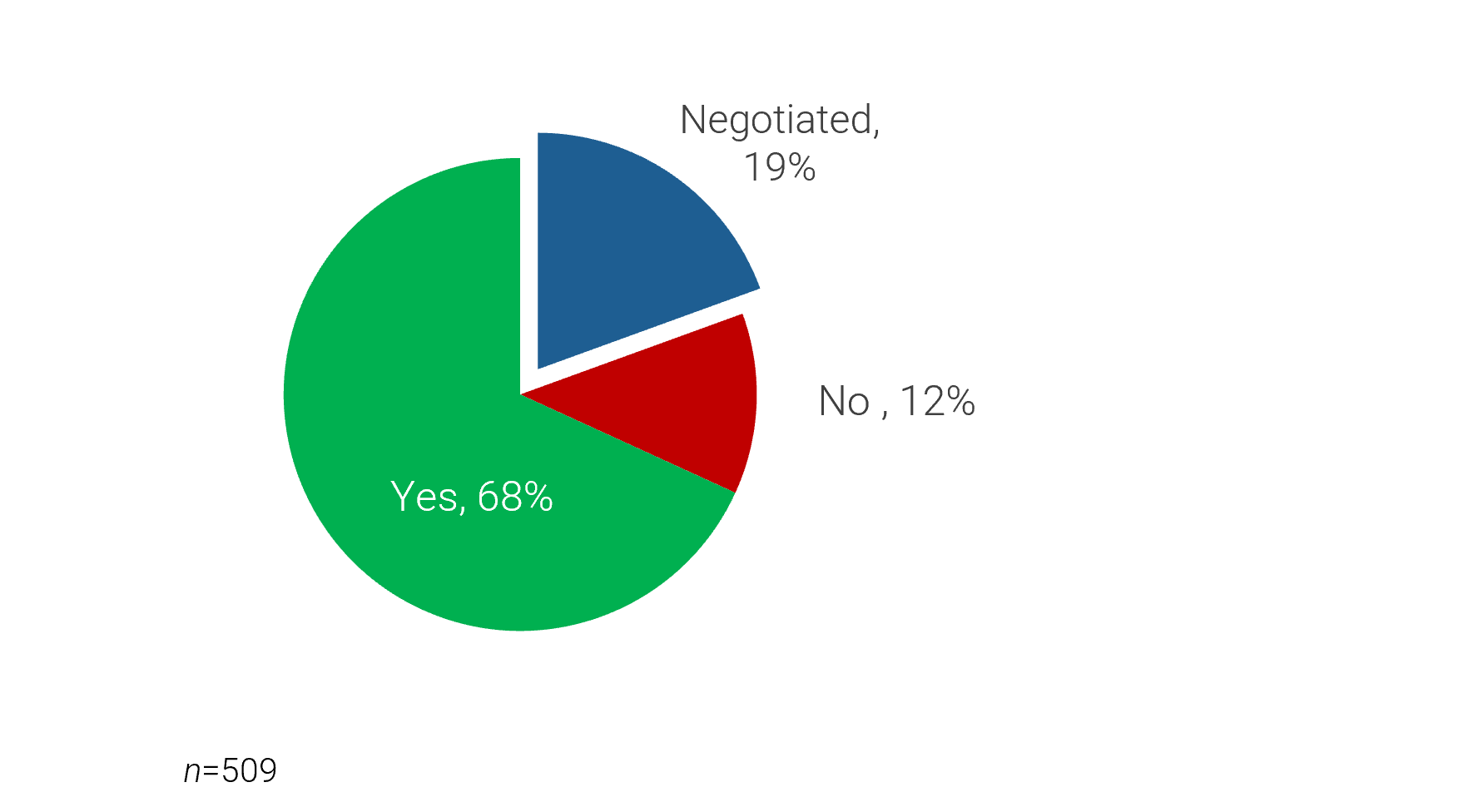
For most organizations, employees get a choice of which days they spend working remotely. This autonomy can range from complete freedom to a choice between several pre-approved days depending on team scheduling needs.
Work is still needed to increase autonomy in hybrid teams
Organizations’ success in establishing hybrid team autonomy varies greatly post pandemic. Responses are roughly equally split between staff feeling more, less, or the same level of autonomy as before the pandemic. Evaluated in the context of most organizations continuing a hybrid approach, this leads to the conclusion that not all hybrid implementations are being conducted equally effectively when it comes to employee empowerment.
As an employee, how much control do you have over the decisions related to where, when, and how you work currently?

Connectedness in hybrid teams lags behind
A strong case can be made for fostering autonomy and empowerment on hybrid teams. Employees who report lower levels of control than before the pandemic also report lower engagement indicators, such as trust in senior leadership, motivation, and intention to stay with the organization. On the other hand, employees experiencing increased levels of control report gains in these areas.
The only exception to these gains is the sense of team connectedness, which employees experiencing more control report as lower than before the pandemic. A greater sense of connectedness among employees reporting decreased control may be related to more mandatory in-office time or a sense of connection over shared team-level disengagement.
These findings reinforce the need for hybrid teams to invest in team building and communication practices and confirm that significant benefits are to be had when a sense of autonomy can be successfully instilled.
Employees who experience less control than before the pandemic report lowered engagement indicators ... except sense of connectedness
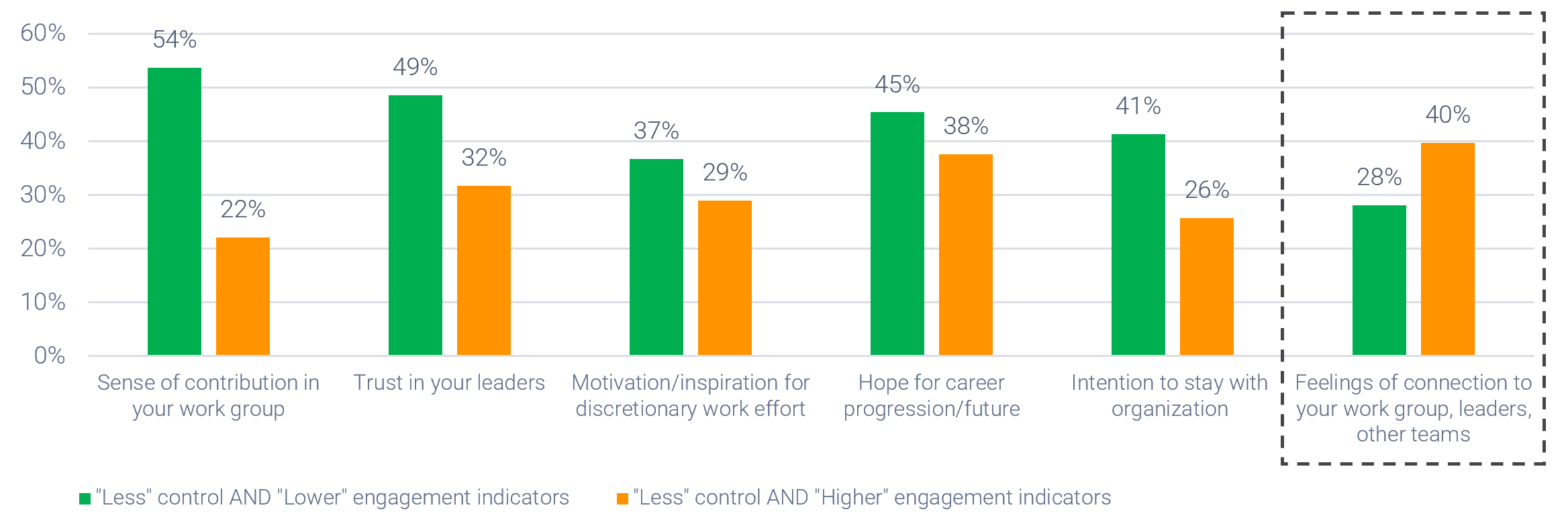
Employees who experience more control than before the pandemic report increased engagement indicators ... except sense of connectedness
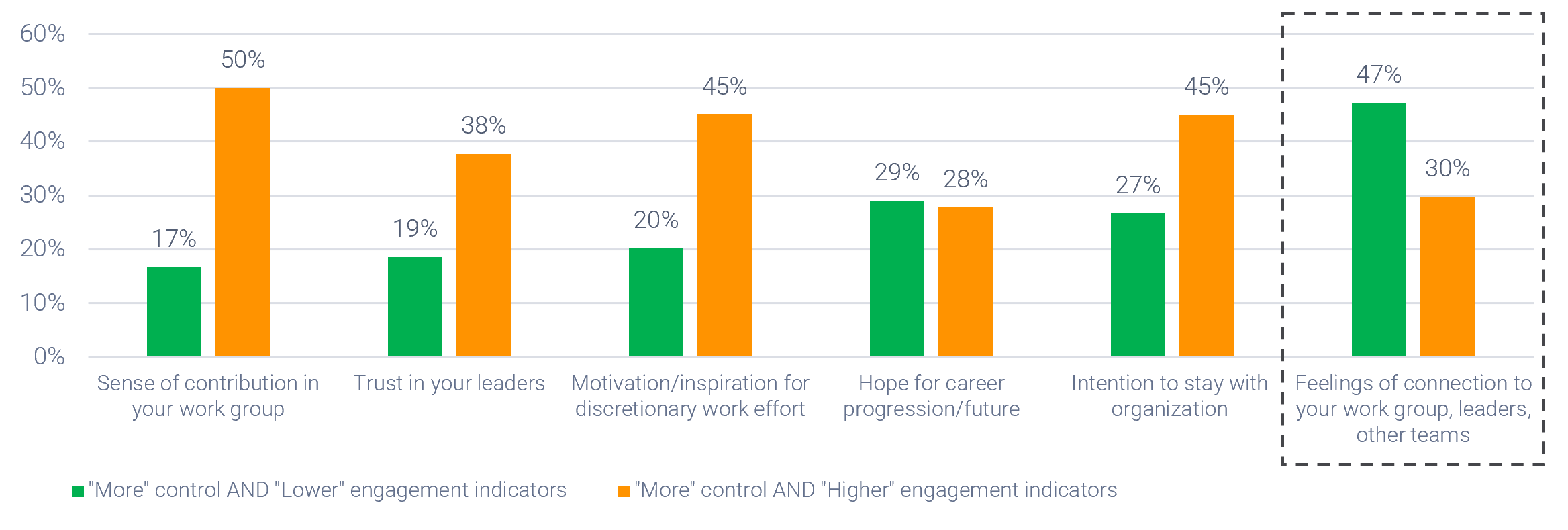
Case study: Hybrid work at Microsoft Canada
|
The Power of Intentionality When the pandemic hit, technology was not in question. Flexible work options had been available and widely used, and the technology to support them was in place. The leadership team turned their focus to ensuring their culture survived and thrived. They developed a laser-focused approach for engaging their employees by giving their leaders tools to hold conversations. The dialogue was ongoing to allow the organization to adapt to the fast pace of changing conditions. Every tactic, plan, and communication started with the question, “What outcome are we striving for?” With a clear outcome, tools were created and leaders supported to drive the desired outcome. |
“We knew we had the technology in place. Our concern was around maintaining our strong culture and ensuring continued engagement and connection with our employees.” – Lisa Gibson, Chief of Staff, Microsoft Canada |
How we can help
Metrics
| Resources Webinar: Effectively Manage Remote Teams Build a Better Manager: Manage Your People |
For a comprehensive list of resources, visit
Info-Tech’s Hybrid Workplace Research Center
Recommendations
The last two years have been a great experiment, but it’s not over.
|
BE INTENTIONAL
|
|
INVOLVE EMPLOYEES
|
|
ALLOW CHOICE
|
|
BE TRANSPARENT
|
Info-Tech Insight
Hybrid and remote teams require more attention, connection, and leadership from managers. The shift from doing the day-to-day to effectively leading is critical for the success of nontraditional work models. As hybrid and remote work become engrained in society, organizations must ensure that the concept of the “working manager” is as obsolete as the rotary telephone.
Bibliography
“8 Unexpected Benefits of Online Learning for Development.” Center for Creative Leadership (CCL), 14 Oct. 2020. Accessed 5 Nov. 2021.
“2021 Global Workplace Report.” NTT, 2021. Accessed 6 July 2022.
“Advantages of Online Learning for Leadership Development: What Our Research Says.” CCL, 8 Dec. 2020. 5 Nov. 2021.
“Annual Work Trend Index Report – Great Expectations: Making Hybrid Work Work.” Microsoft WorkLab, 2022. Accessed 6 July 2022.
Aten, Jason. “Google’s Employees Return to the Office Today. This Former Exec Says Hybrid Work Won’t Last.” Inc.Com, 4 April 2022. Web.
Bariso, Justin. “Google Spent 2 Years Researching What Makes a Great Remote Team. It Came Up With These 3 Things.” Inc.Com, 8 April 2019. Web.
Berger, Chloe. “What Is ‘Hybrid Guilt’? Going to Office Part-Time May Be Worst Option.” Fortune, 22 Aug. 2022. Web.
Brodkin, Jon. “After Remote-Work Ultimatum, Musk Reveals Plan to Cut 10% of Tesla Jobs.” Ars Technica, 3 June 2022. Web.
Brown, Brené, host. “Brené with Scott Sonenshein on Why We’ll Never Be the Same Again (and Why It’s Time to Talk About It).” Dare to Lead with Brené Brown, 11 April 2022. Brené Brown, https://brenebrown.com/podcast/why-well-never-be-the-same-again-and-why-its-time-to-talk-about-it/.
Burgess, Mark. “Most Asset Managers Operating Under Hybrid Work Model: Survey.” Advisor’s Edge, 13 Sept. 2022. Web.
Caminiti, Susan. “Workers Want Hybrid but Say It’s Exhausting Them. Here’s How Companies Can Fix That.” CNBC, 8 Feb. 2022. Web.
Capossela, Chris. “The next Chapter of Our Hybrid Workplace: Update on Our Washington State Work Sites.” The Official Microsoft Blog, 14 Feb. 2022. Web.
Carrigan, John. “Meta Embraces ‘Work From Anywhere’ Ahead of Return to Office.” Human Resources Director, 25 March 2022. Web.
Chaturvedi, H., and Ajoy Kumar Dey. The New Normal: Reinventing Professional Life and Familial Bonding in the Post COVID 19 Era. Bloomsbury Publishing, 2021.
Commonwealth of Massachusetts. “Alternative Work Options.” Mass.Gov, n.d. Accessed 17 Sept. 2022.
Commonwealth of Massachusetts. “Hybrid Work for Commonwealth Employees.” Mass.Gov, n.d. Accessed 17 Sept. 2022.
“COVID-19 and the Future of Business.” IBM, 21 Sept. 2020. Web.
Daniel, Will. “The Layoffs at Tesla Show That White-Collar Workers Are Screwed, Hedge Funder Famous from ‘The Big Short’ Predicts.” Fortune, 29 June 2022. Web.
D’Auria, Gemma, and Aaron De Smet. “Leadership in a Crisis: Responding to Coronavirus.” McKinsey, 16 March 2020. Web.
Dave, Paresh. “Google Mandates Workers Back to Silicon Valley, Other Offices from April 4.” Reuters, 3 March. 2022. Web.
Delaney, Kevin. “What We Know Now About the Business Impact of Hybrid Work.” Time, 6 Sept. 2022. Web.
Dobson, Sarah. “Legal Considerations for Hybrid Work.” Canadian HR Reporter, 15 Sept. 2022. Web.
Dondo, Jean. “Hybrid Work Is the Way for More Than a Quarter of Canadian Investment Firms.” Wealth Professional, 14 Sept. 2022. Web.
Elias, Jennifer. “Twitter to Reopen Offices March 15, Though Remote Work Remains an Option.” CNBC, 3 March 2022. Web.
Esade Business & Law School. “Leadership After Covid-19: Learning To Navigate The Unknown Unknowns.” Forbes, 30 March 2021. Web.
“Famous Companies Without Offices.” The Hoxton Mix, 19 Oct. 2021. Web.
Gerdeman, Dina. “COVID Killed the Traditional Workplace. What Should Companies Do Now?” HBS Working Knowledge, 8 March 2021. Web.
Gleason, Mike. “Apple’s Hybrid Work Plans Draw Worker Pushback.” SearchUnifiedCommunications, TechTarget, 24 Aug. 2022. Web.
Gleeson, Brent. “13 Tips For Leading And Managing Remote Teams.” Forbes, 26 Aug. 2020. Web.
Gratton, Lynda. “How to Do Hybrid Right.” Harvard Business Review, 1 May 2021. Web.
“Guide: Understand team effectiveness.” re:Work, Google, n.d. Accessed 5 Nov. 2021.
Hardy, Karen. “Your Business Has Decided on Hybrid Work… Now What?” CIO, 12 Sept. 2022. Web.
Hirsch, Arlene S. “How to Boost Employee Performance in a Hybrid Work Environment.” SHRM, 6 Sept. 2022. Web.
“How to Get Hybrid Work Right.” CBRE Canada, 14 June 2022. Web.
“Hybrid Work: When Freedom Benefits from Rules.” Audi, 12 Sept. 2022. Accessed 18 Sept. 2022.
“Hybrid Workplace | Global Culture Report.” O.C. Tanner, 2022, Web.
“Intel Is Hiring for Various Roles with Temporary Remote Work Benefits.” SightsIn Plus, 11 June 2022. Web.
Iyer, Viswanathan. “Council Post: Hybrid Work: Beyond The Point Of No Return.” Forbes, 14 Sept. 2022. Web.
Johnson, Ricardo. “Securing Hybrid Work All Starts with Zero-Trust.” SC Media, 29 Aug. 2022. Web.
Jones, Jada. “The Rules of Work Are Changing, and Hybrid Work Is Winning.” ZDNET, 1 Sept. 2022. Web.
Kowitt, Beth. “Inside Google’s Push to Nail Hybrid Work and Bring Its 165,000-Person Workforce Back to the Office Part-Time.” Fortune, 17 May 2022. Web.
Kumra, Gautam, and Diaan-Yi Lin. “The Future of (Hybrid) Work.” McKinsey, 2 Sept. 2022. Web.
Lagowska, Urszula, et al. “Leadership under Crises: A Research Agenda for the Post-COVID-19 Era.” Brazilian Administration Review, vol. 17, no. 2, Aug. 2020. Web.
Larson, Barbara Z., et al. “A Guide to Managing Your (Newly) Remote Workers.” Harvard Business Review, 18 March 2020. Web.
“Leadership During COVID-19: Resources for Times of Uncertainty.” CCL, n.d. Accessed 5 Nov. 2021.
“Managing Remote Employees: How to Lead From a Distance.” CCL, 7 April 2020. Accessed 5 Nov. 2021.
“Managing Remote Teams.” Know Your Team, n.d. Web. Accessed 5 Nov. 2021.
Mayhem, Julian. “Virtual Leadership - Essential Skills for Managing Remote Teams.” VirtualSpeech, 4 Nov. 2020. Web.
McKendrick, Joe. “Keeping Hybrid Workers In Sync, Digitally And In-Person.” Forbes, 22 Aug. 2022. Web.
McKenna, Karissa, et al. “Webinar: Build Leadership Skills for the New World of Work.” CCL, 15 June 2020. Accessed 5 Nov. 2021.
Mearian, Lucas. “Microsoft Edges Back to ‘Normal’ with Workplace Reopening Plan.” Computerworld, 14 Feb. 2022. Web.
“Meta Careers.” Meta, n.d. Accessed 17 Sept. 2022.
Miller, Mark. “5 Tips to Make Your Hybrid Work Model More Effective.” Entrepreneur, 25 Aug. 2022. Web.
Nica, Irina. “How to Manage a Remote Team: 14 Effective Tips for Your Business.” Business 2 Community, 8 July 2021. Web.
O’Halloran, Joe. “Organisations Struggle to Support IT in a Hybrid Work Model.” ComputerWeekly.com, 17 June 2022. Web.
Ong, Ivan. “Council Post: Why Hybrid Work Is The Way To Go.” Forbes, 12 Sept. 2022. Web.
Osborne, Charlie. “The End of Fully Remote Work? Google Begins Shift to the Hybrid Office.” ZDNet. 3 March 2022. Web.
Pazzanese, Christina. “Back to Office? Stay Remote? Go Hybrid?” Harvard Gazette, 24 Aug. 2022. Web.
“PinFlex.” Pinterest Careers, n.d. Accessed 17 Sept. 2022.
Rand, Ben. “Does Hybrid Work Actually Work? Insights from 30,000 Emails.” Harvard Business School – Working Knowledge, 6 Sept. 2022. Web.
“Remote Locations, Working with Flexibility.” Amazon.jobs, n.d. Accessed 17 Sept. 2022.
Renjen, Punit. “The Heart of Resilient Leadership: Responding to COVID-19.” Deloitte Insights, 16 March 2020. Web.
Shih, Clara. “Keeping Hybrid Employees Engaged.” Harvard Business Review, 11 Aug. 2022. Web.
Singerman, Michelle. “Is the Hybrid Work Model Working? CPAs Spill the Beans.” Chartered Professional Accountants Canada, 24 Aug. 2022. Web.
Stern, Stefan. “Hybrid Working: Why the Office-Home Balance Is Still a Challenge.” Financial Times, 4 Sept. 2022.
Subramaniam, Vanmala, et al. “Ready to Go Back to the Office? Employers and Workers Are Divided over the Fate of Remote Work.” The Globe and Mail, 1 Sept. 2022. Web.
Tong, Goh Chiew. “Inflation and Hybrid Work ‘skyrocketed’ Demand for Flexible Workspace, WeWork Says.” CNBC, 6 Sept. 2022. Web.
Tsipursky, Gleb. “Commentary: The Psychology behind Why Some Leaders Are Resisting a Hybrid Work Model.” Fortune, 8 June 2021. Web.
Turner, Jack. “Tesla Doubles Down on Remote Working Ban, Tracks Office Attendance.” Tech.Co, 3 July 2022. Web.
“Virtual Leadership Styles for Remote Businesses.” Maryville Online, 4 Feb. 2021. Web.
“Webinar: How Leaders Can Build Organizational Resilience.” CCL, 15 June 2020. Accessed 5 Nov. 2021.
“Why GitLab Uses the Term All-Remote to Describe Its 100% Remote Workforce.” GitLab, 2022. Accessed 17 Sept. 2022.
Wigert, Ben, and Sangeeta Agrawal. “Returning to the Office: The Current, Preferred and Future State of Remote Work.” Gallup, 31 Aug. 2022. Web.
Wingard, Jason. “Elon Musk’s Big Bet Against Remote Work: Will Tesla Win?” Forbes, 4 June 2022. Web.